Table
Table charts have rich functionalities, capable of displaying complex Chinese-style reports, supporting various calculations and statistics on data, allowing for comparative viewing of metric data, and supporting various interactive operations such as linking and jumping.
Table Creation
This section introduces the process of creating a table using a product sales order table as an example.
- In the dashboard, click New Chart -> Table, select the data source and dataset, and click OK.
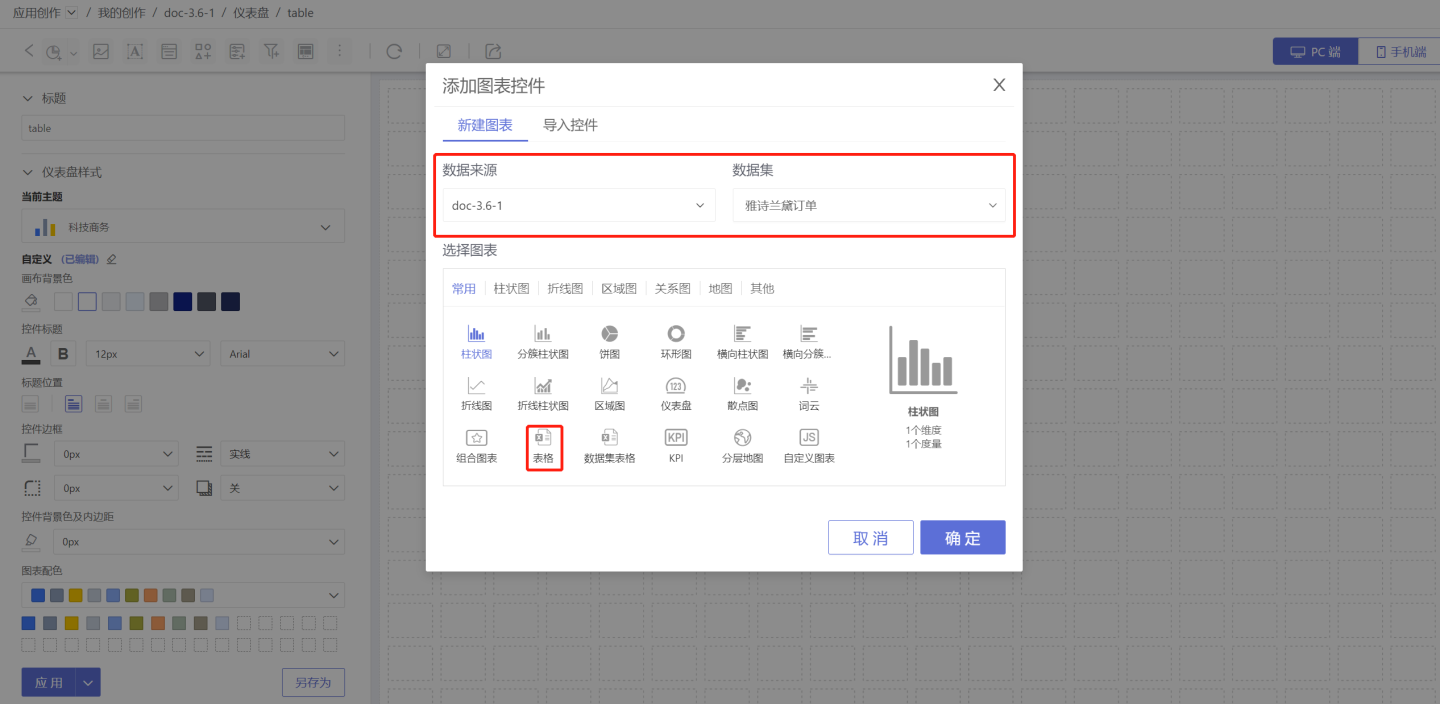
- Drag the fields to be displayed into the dimensions, such as region, store, order number, and product name.
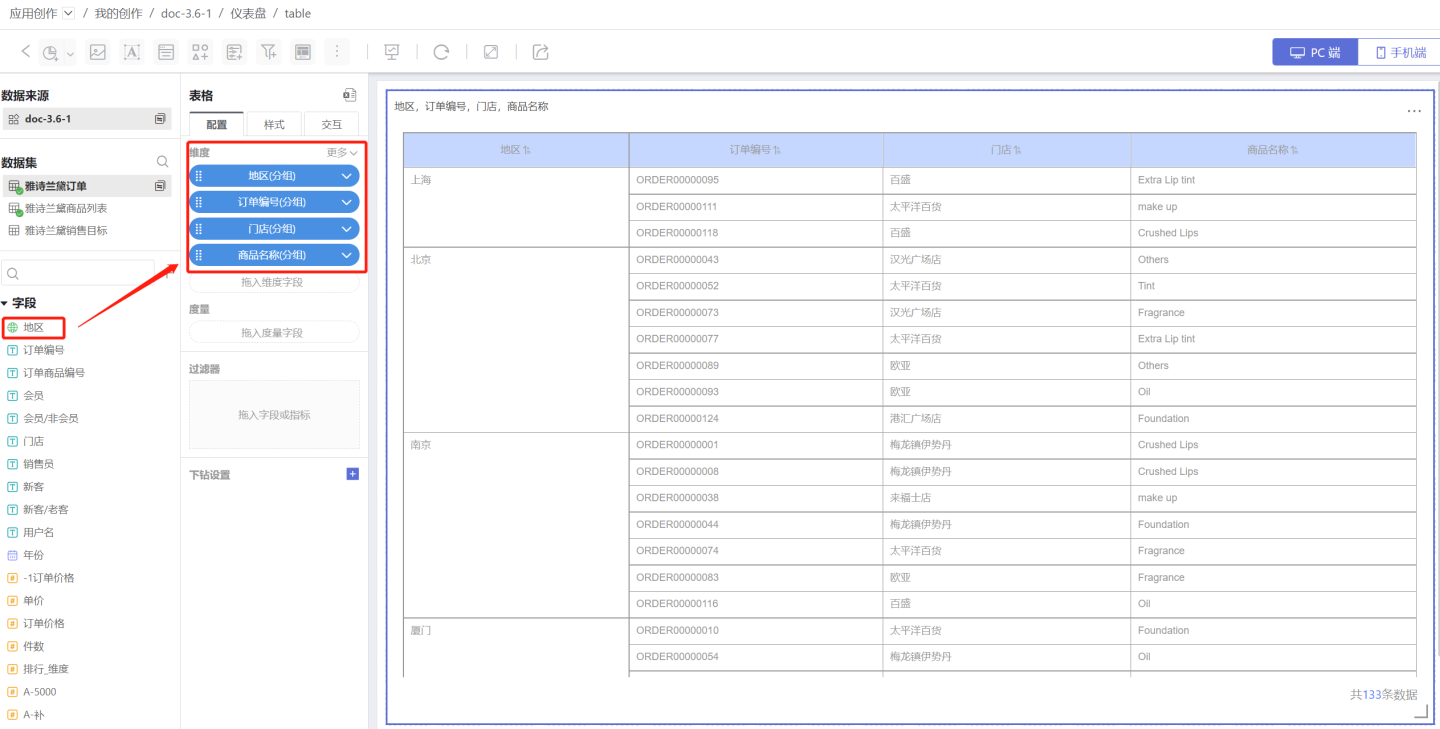
- Drag the measure fields, such as order price, and drag the comparison dimensions, such as comparing the order prices of members and non-members.
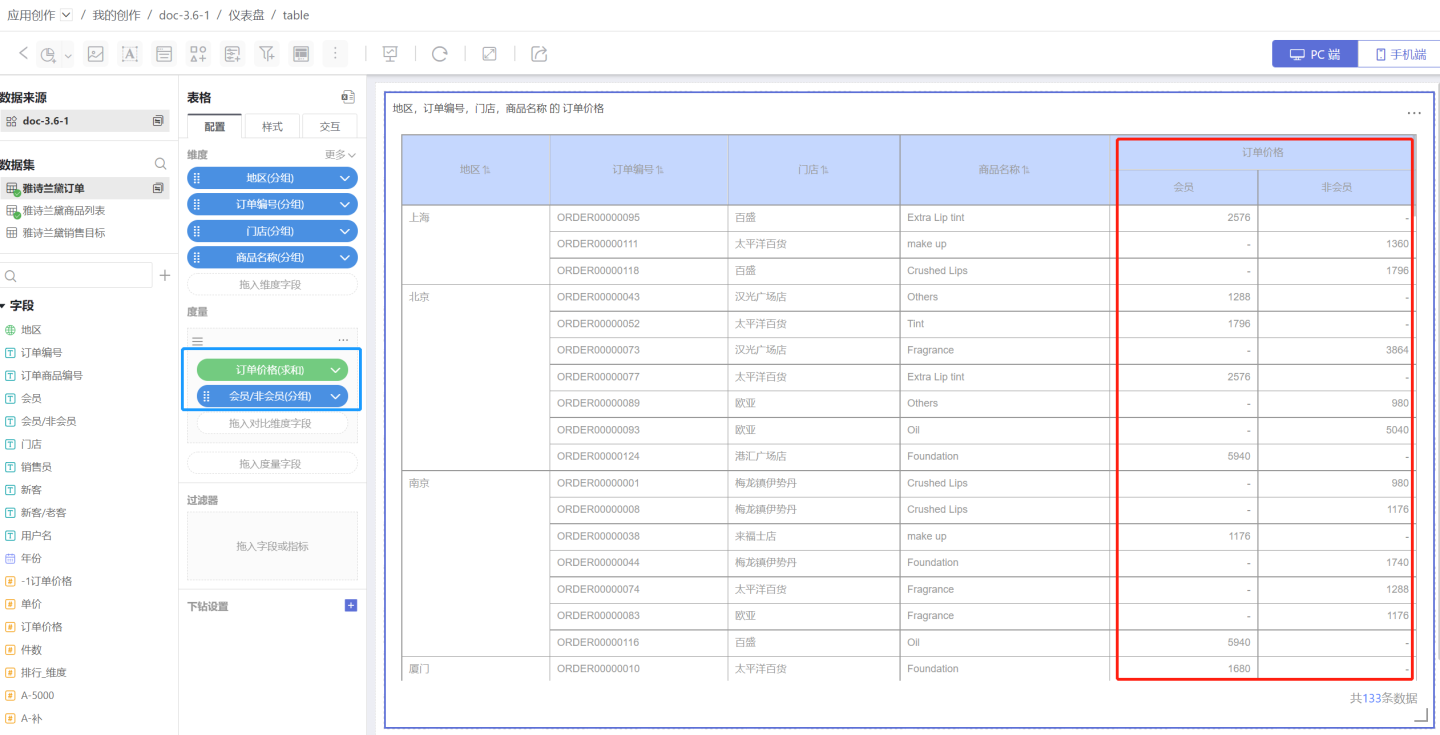
- Add subtotals to display statistical information. The dimension subtotal (red box) sums up the sales of each region's stores. The comparison dimension measure subtotal (blue box) sums up the sales orders of members and non-members, completing the basic configuration of the table.
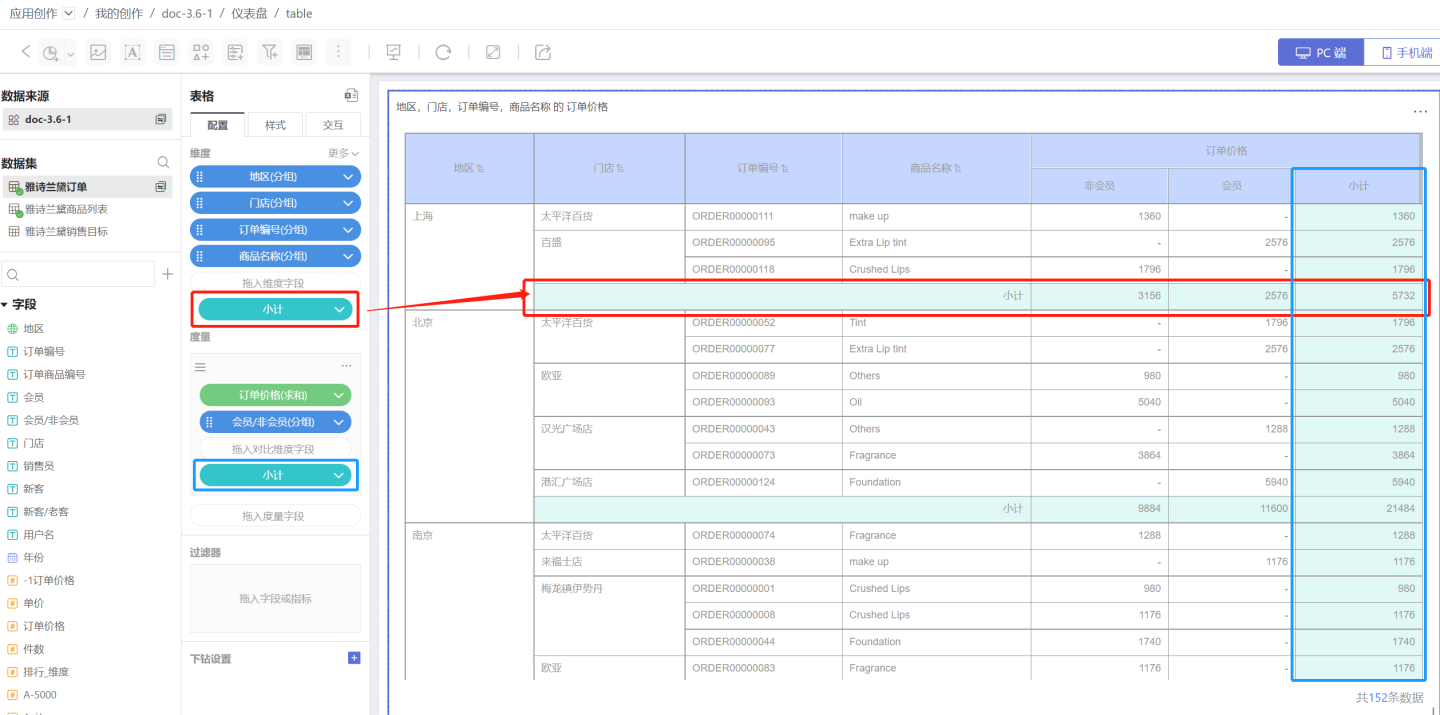
- Set the Table Style, add serial numbers, set the header and cell colors, and adjust the position and style of the subtotals.
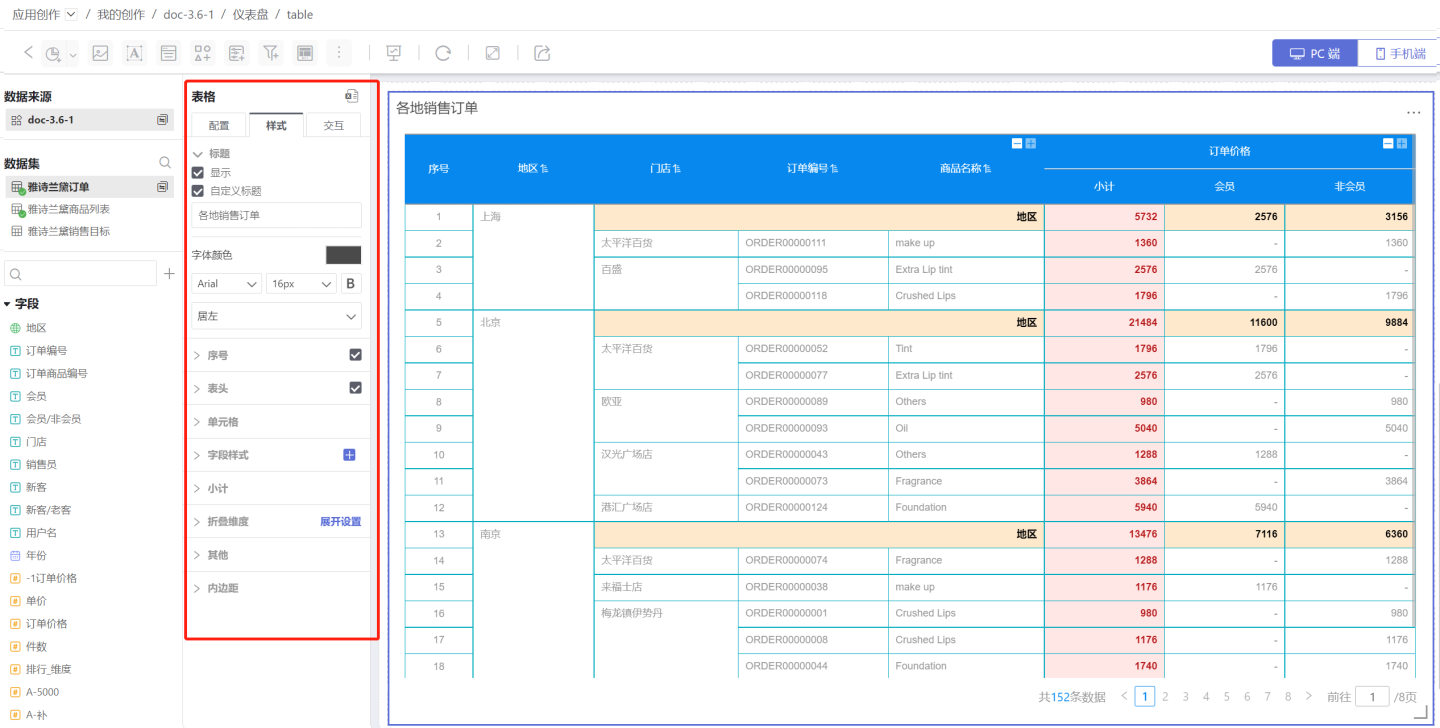
- Set the Interactive Features of the table. In the example, the number of items displayed per page is set to 20, a pager is added, the roll-up and drill-down functions are enabled, and the interactive behavior after opening the table is set.
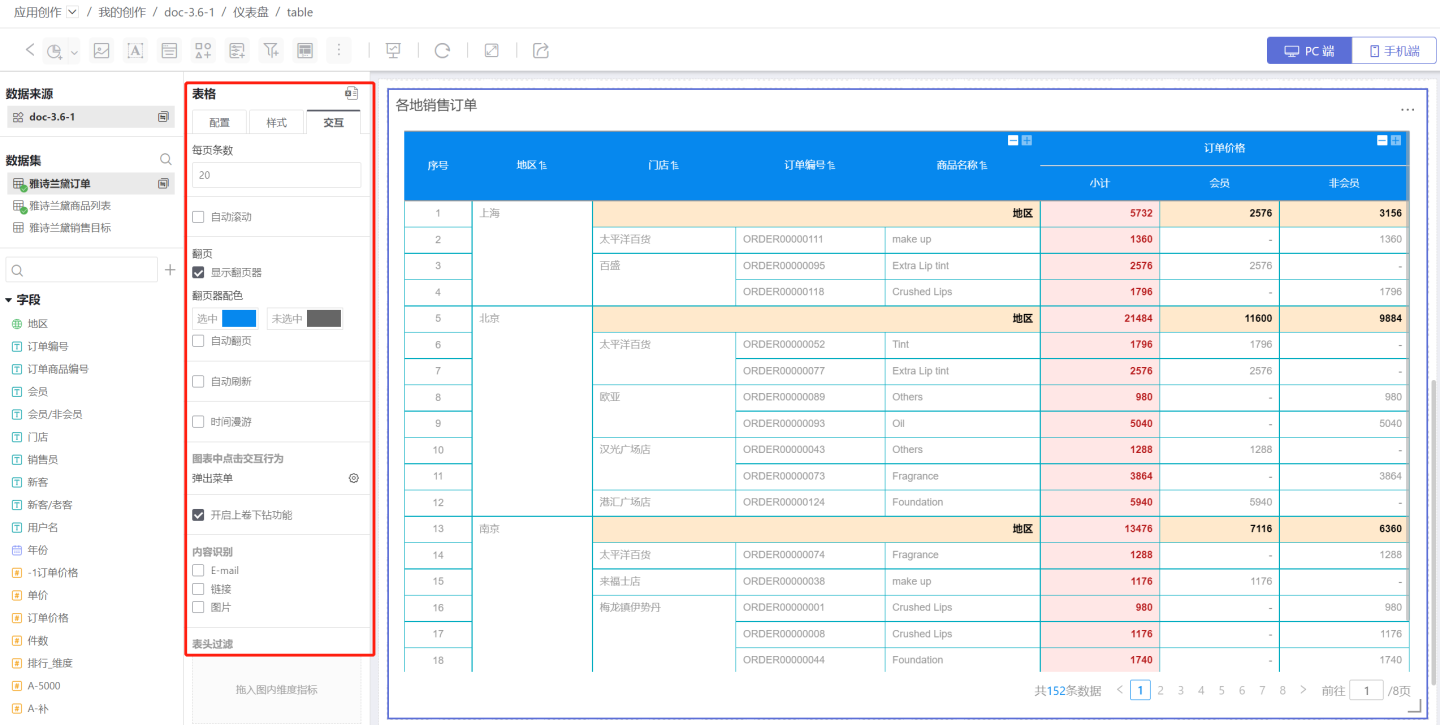
- Set the style of the table control and its interaction with other charts. In the example, the chart is set to jump to a ranking dashboard.

Configuration
The above example briefly introduces the process of creating a table. Below, we will provide a detailed introduction to the configuration options for the table.
Dimension
Adding Dimensions
- Multiple dimensions can be added in sequence, with the first dimension being the primary dimension and the subsequently added dimensions being secondary dimensions. The order of dimensions can be adjusted.
- All dimensions are arranged from left to right in the order they are added, positioned at the far left of the table header, following the principle of dimensions before measures.
- Users can customize and modify the names of the dimensions.
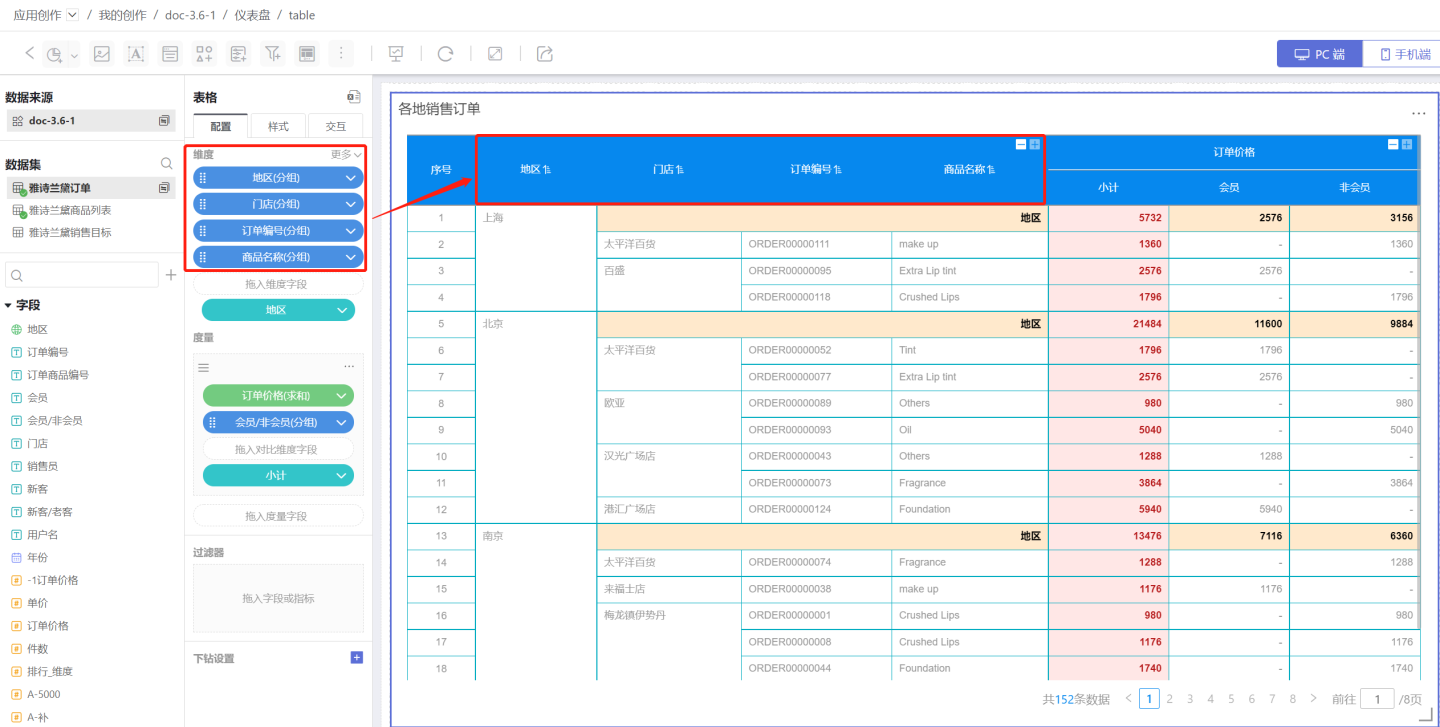
Dimension Sorting
Dimension sorting includes: sorting by the dimension itself, sorting by the dimension's pinyin, sorting by a specified field, sorting by a measure within the chart, and manual sorting. When there are multiple dimensions to sort, the primary dimension is sorted first, and then the secondary dimension is sorted based on the results of the primary dimension's sorting.
Sorting by the Dimension Itself Refers to the order of this column within the dataset. As shown in the figure, the ascending order of the region dimension is Shanghai, Beijing, Nanjing, which is the same as the ascending order of this column in the dataset.
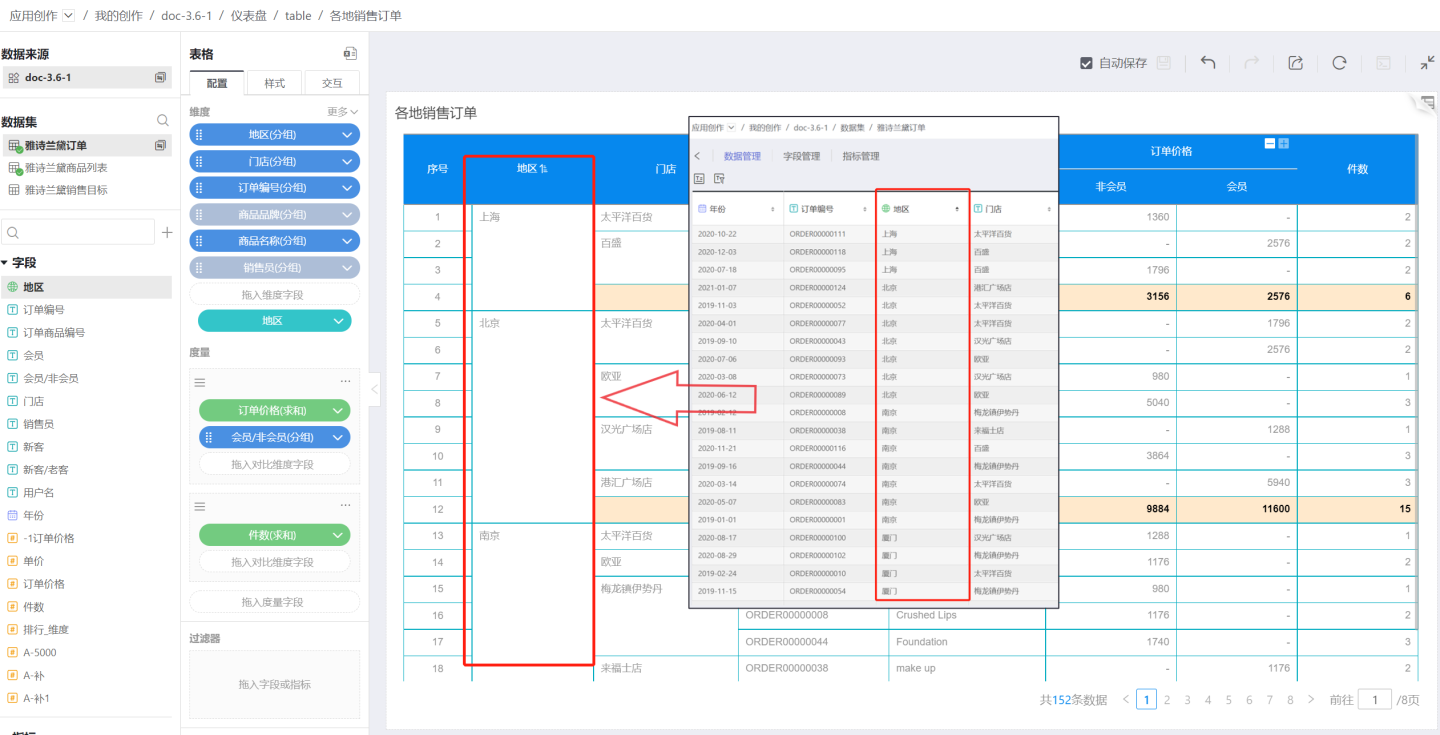
Sorting by the Dimension's Pinyin Text-type fields are sorted according to the pinyin order A-Z. Date-type and number-type dimension fields do not have alphabetical sorting.

Sorting by a Specified Field You can choose a field from the same dataset or a related dataset, specify an aggregation method, and then sort the dimension according to the aggregated result.
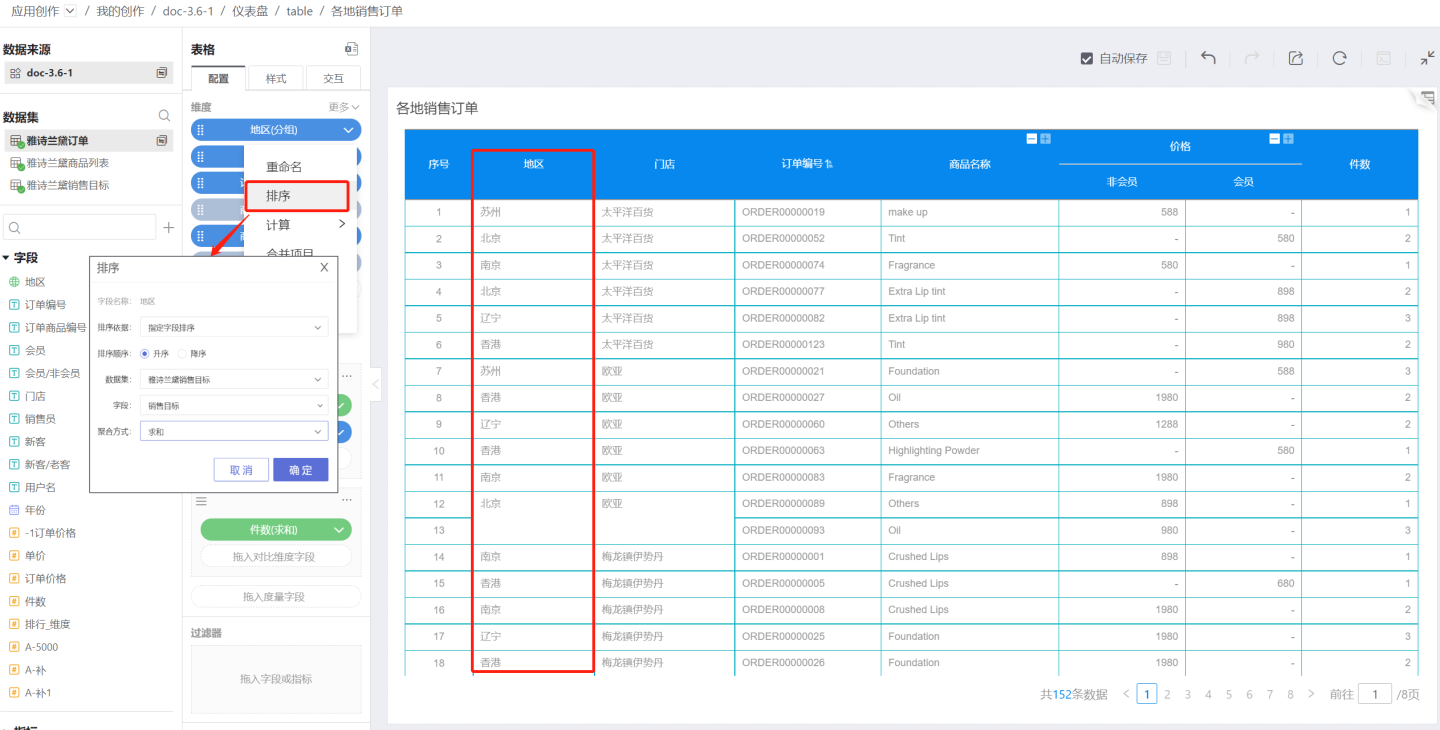
The operation in sorting by a specified field defaults to sorting globally according to the current dimension. If you want to keep subtotals and details together while sorting independently within multiple groups according to the specified field, you can use the partitioning basis setting when sorting by a specified field.
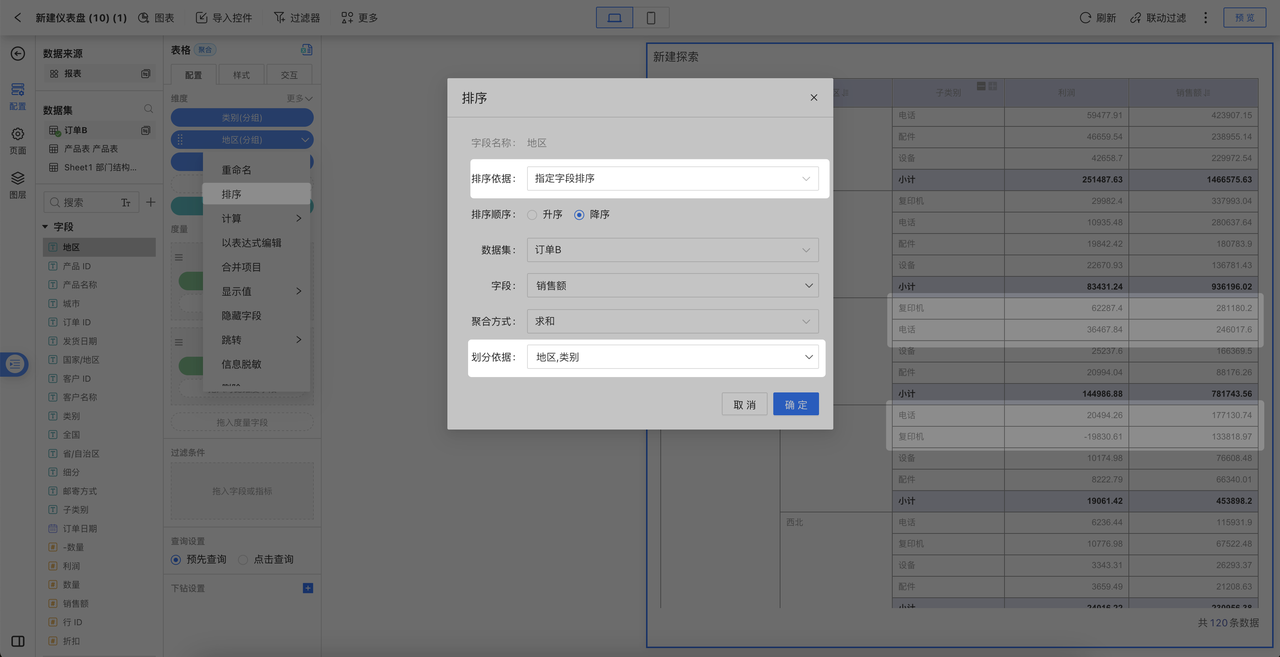
Sorting by a Measure Within the Chart Uses a measure within the table as the sorting basis. When a measure has a comparison dimension, it cannot be used as a sorting basis. As shown in the figure, the price measure already includes a comparison dimension, so it cannot be used as a sorting basis.
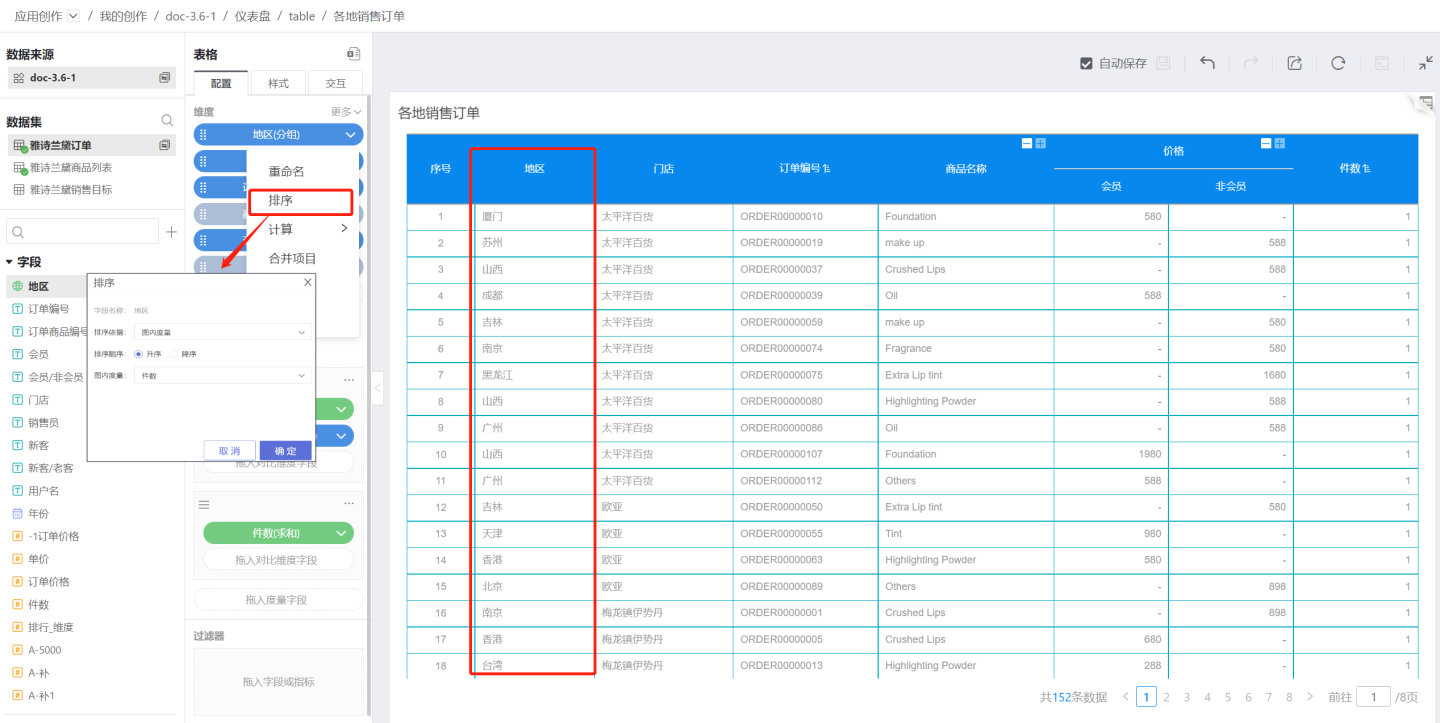
Manual Sorting You can manually adjust the order of dimension groups.
Tip
When the number of sorting field options is less than 254, the exported data from the table is consistent with the sorting. When the number of sorting field options is greater than 254, the exported data from the table is inconsistent with the sorting.
Hidden Fields
Hidden fields refer to fields that are not displayed in the table. In data analysis scenarios, some fields that do not need to be displayed may be passed as parameters to the next report during jumps or drill-downs. This scenario can be achieved using hidden fields. After setting a field as hidden, the field is grayed out and hidden from the list. Hidden fields still exist in the detailed data and can be exported from the detailed data.
Hiding Dimension Fields 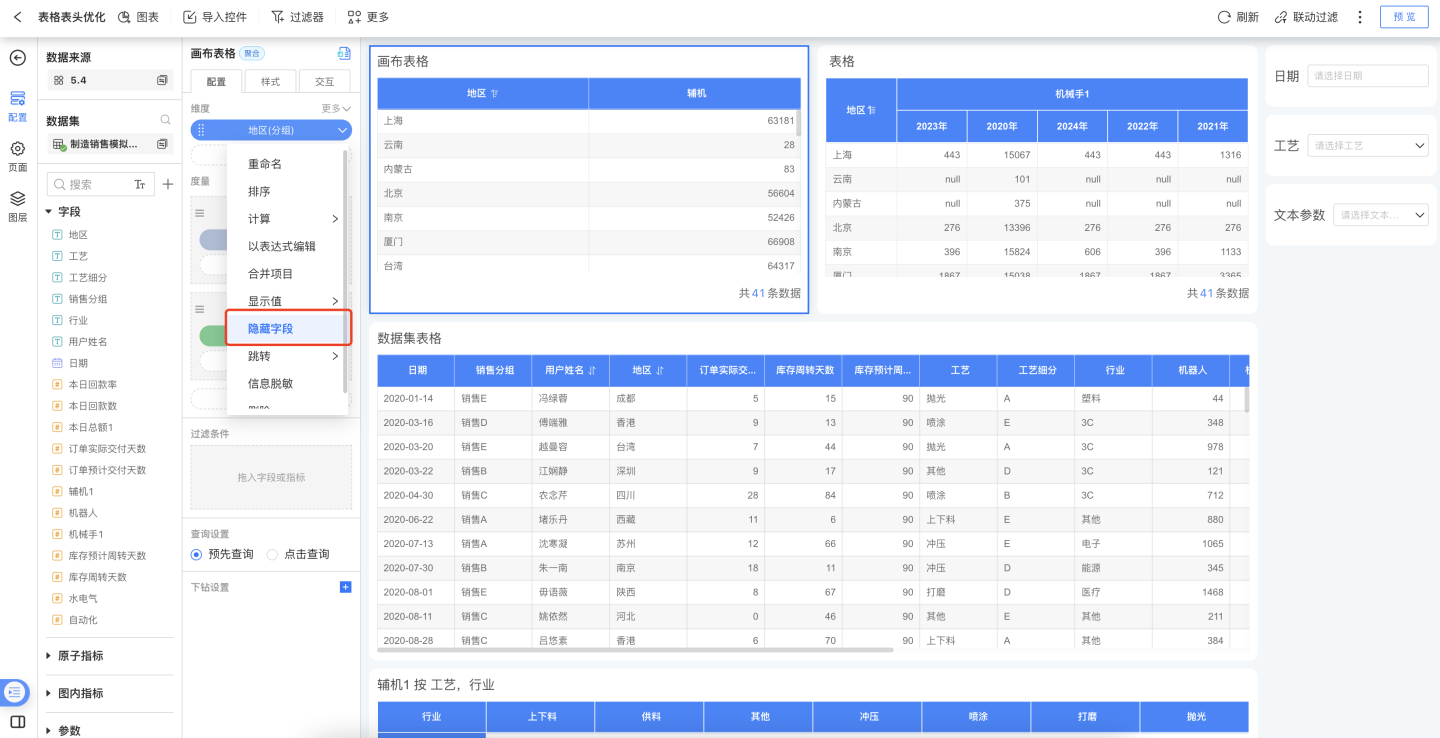
Hiding Measure Fields
When data analysts create tables, if they want to use a measure field as the basis for conditional formatting but do not want to display this measure field in the table, they can achieve this by hiding the measure field. 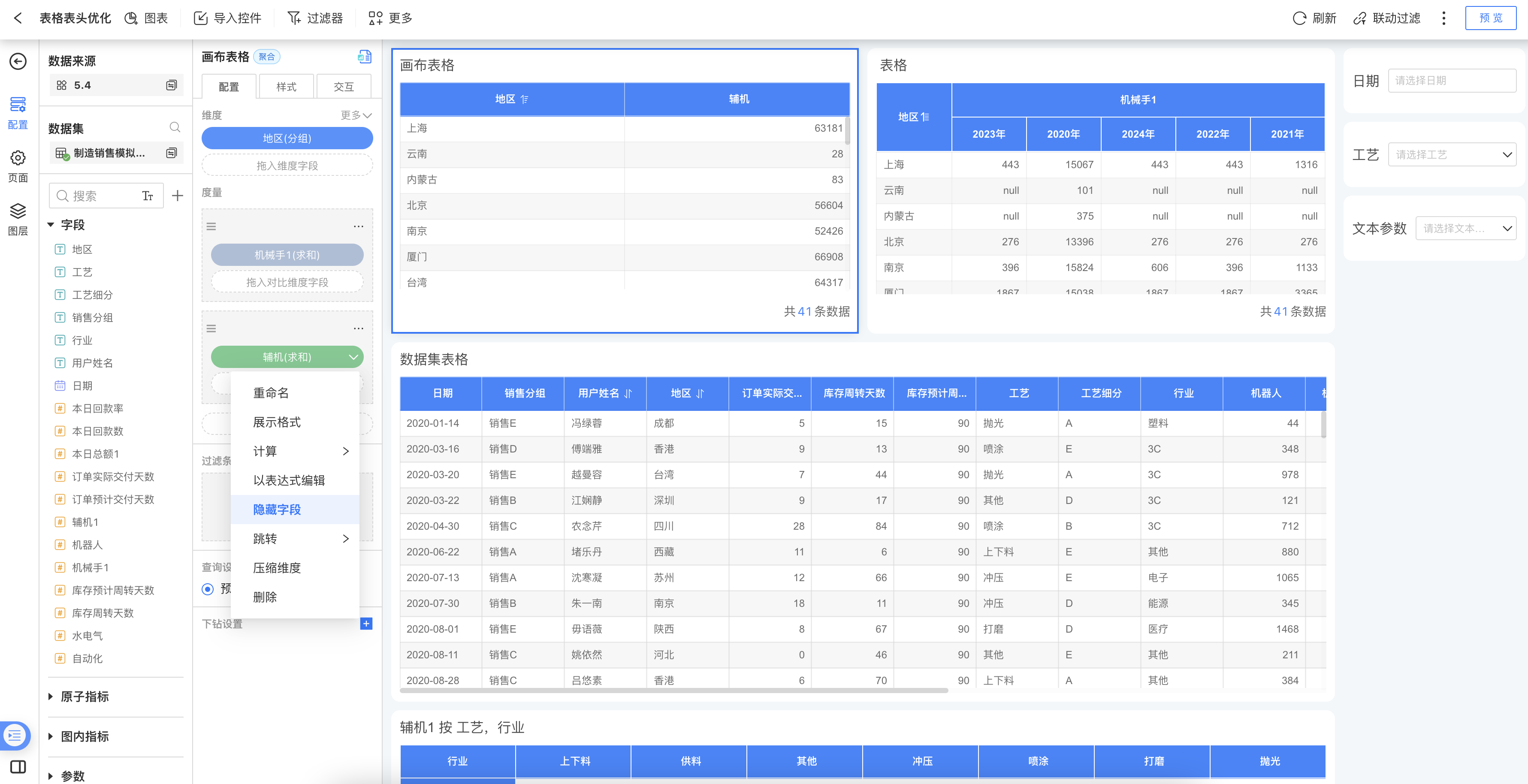
Tip
- When exporting chart data, if the data is less than 1000 rows, it does not include hidden field data. If the data is more than 1000 rows, it includes hidden field data.
- When exporting detailed data, it includes hidden field data.
Field Navigation
In a table, different columns may need to navigate to different destinations. For example, in the table below, clicking on the store column may navigate to the national store summary page, while clicking on the product name column may navigate to the product display page. This can be achieved through field navigation.
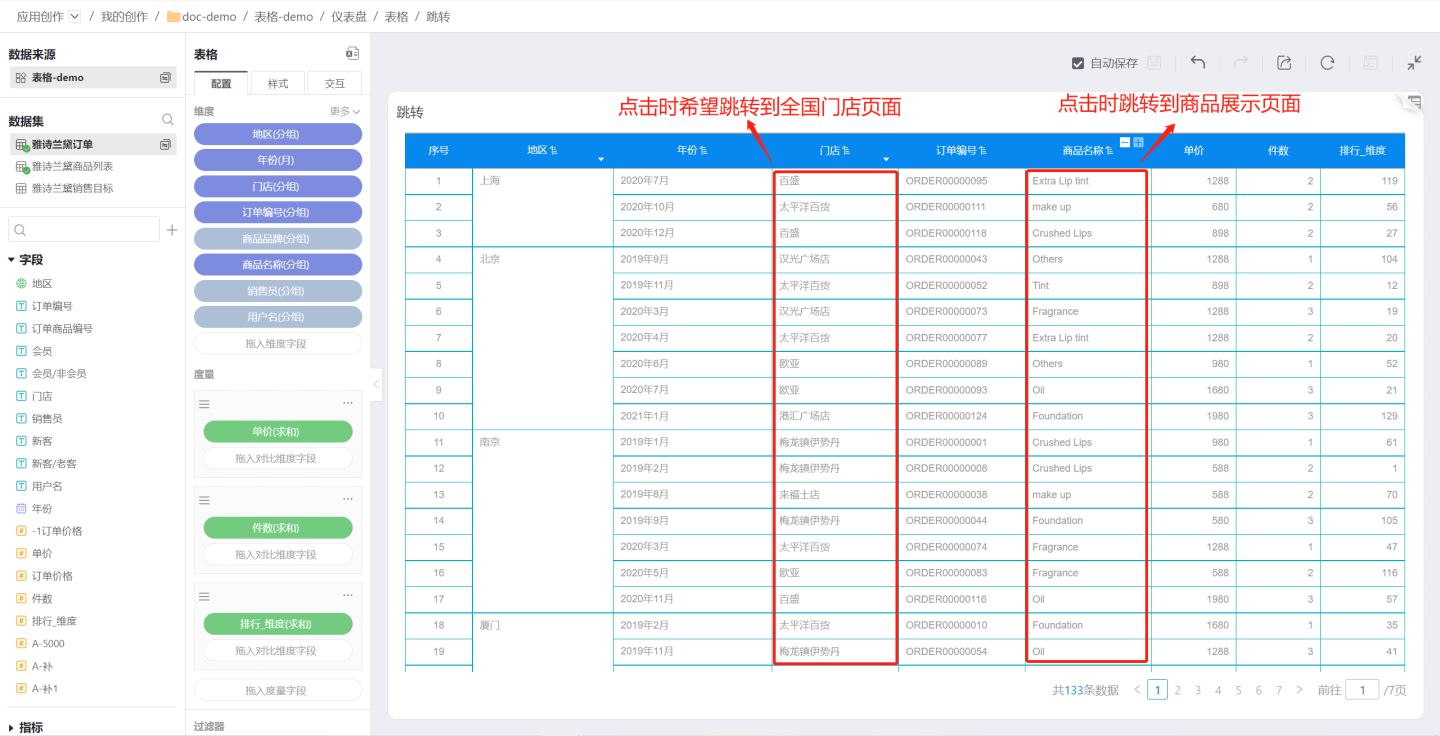
The table supports setting field navigation, control navigation, or both simultaneously.
Set single field navigation. Click the dropdown arrow on the right side of the field, then click on navigation to set the navigation interaction content. In the example, navigation is set for both the store and product name fields. Clicking on the store navigates to the national store summary page, and clicking on the product name navigates to the product display page. After setting the field navigation, a navigation indicator appears on the field.
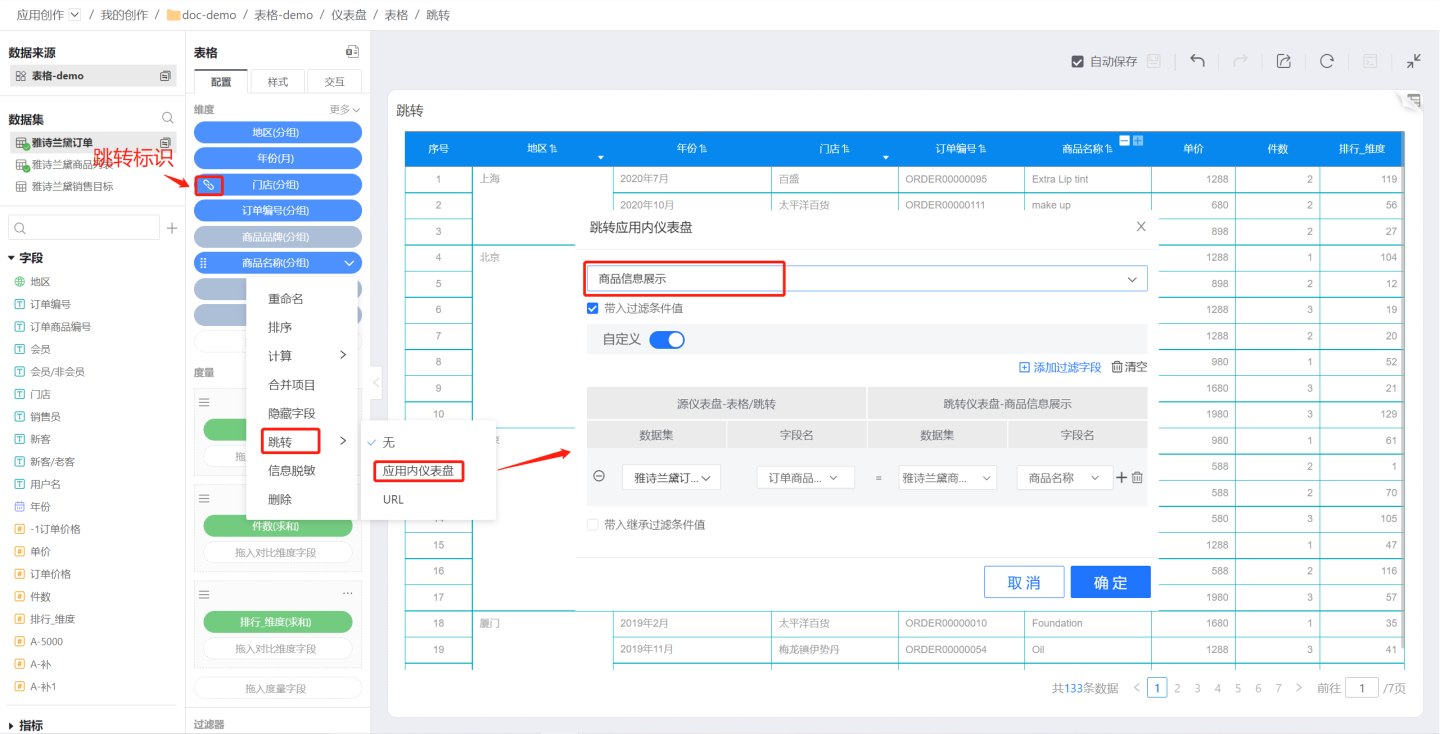
Set table control navigation. Click on the three-dot menu in the table and select control settings, then set the navigation interaction content in the interaction page. In the example, the table is set to navigate to the product information display page. Clicking on any cell in the table will navigate to the product information display page.
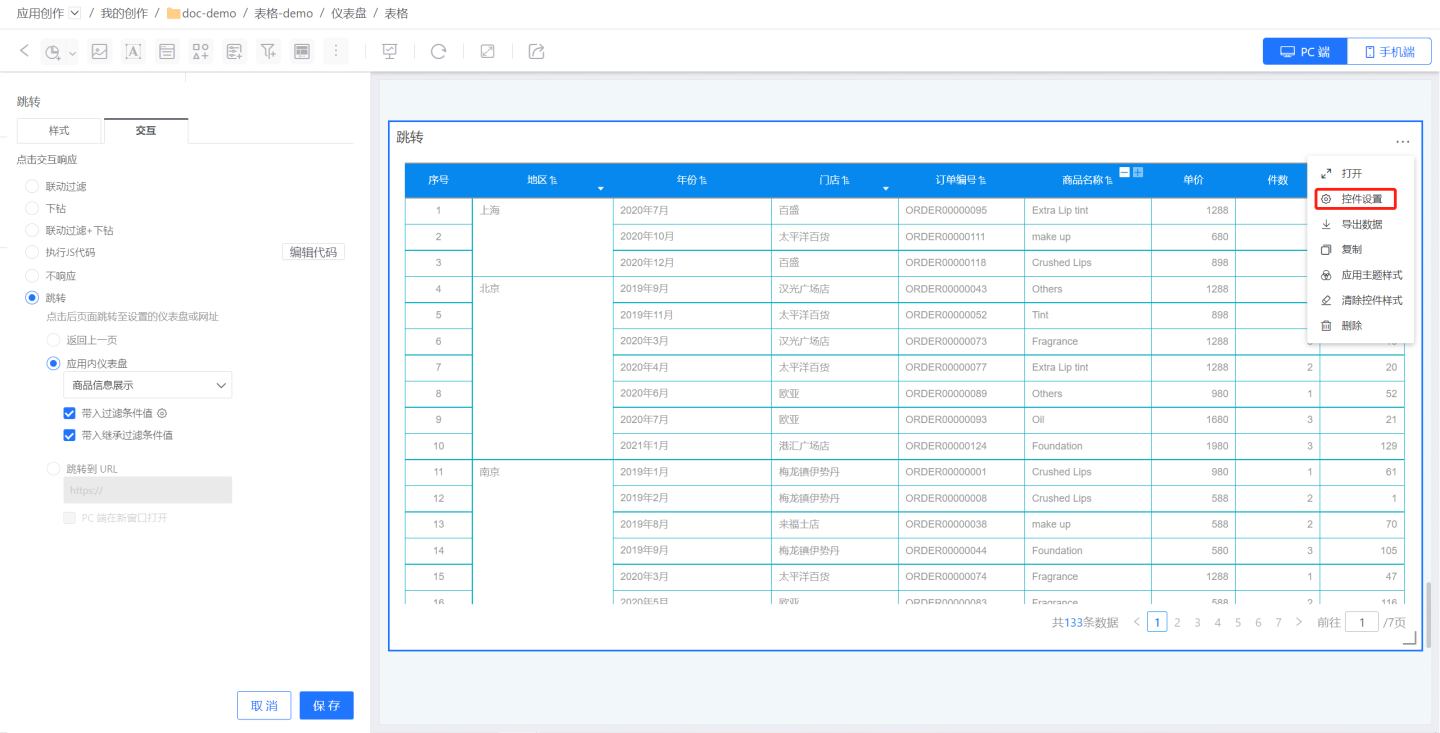
Set both types of navigation interactions simultaneously. The table can set both single field navigation and table control navigation simultaneously. Set them according to the above two methods respectively, with no specific order required. For example, in the example, navigation is set for the store field and the table control. Clicking on the store field navigates to the national store summary page, and clicking on other columns in the table navigates to the product information display page.
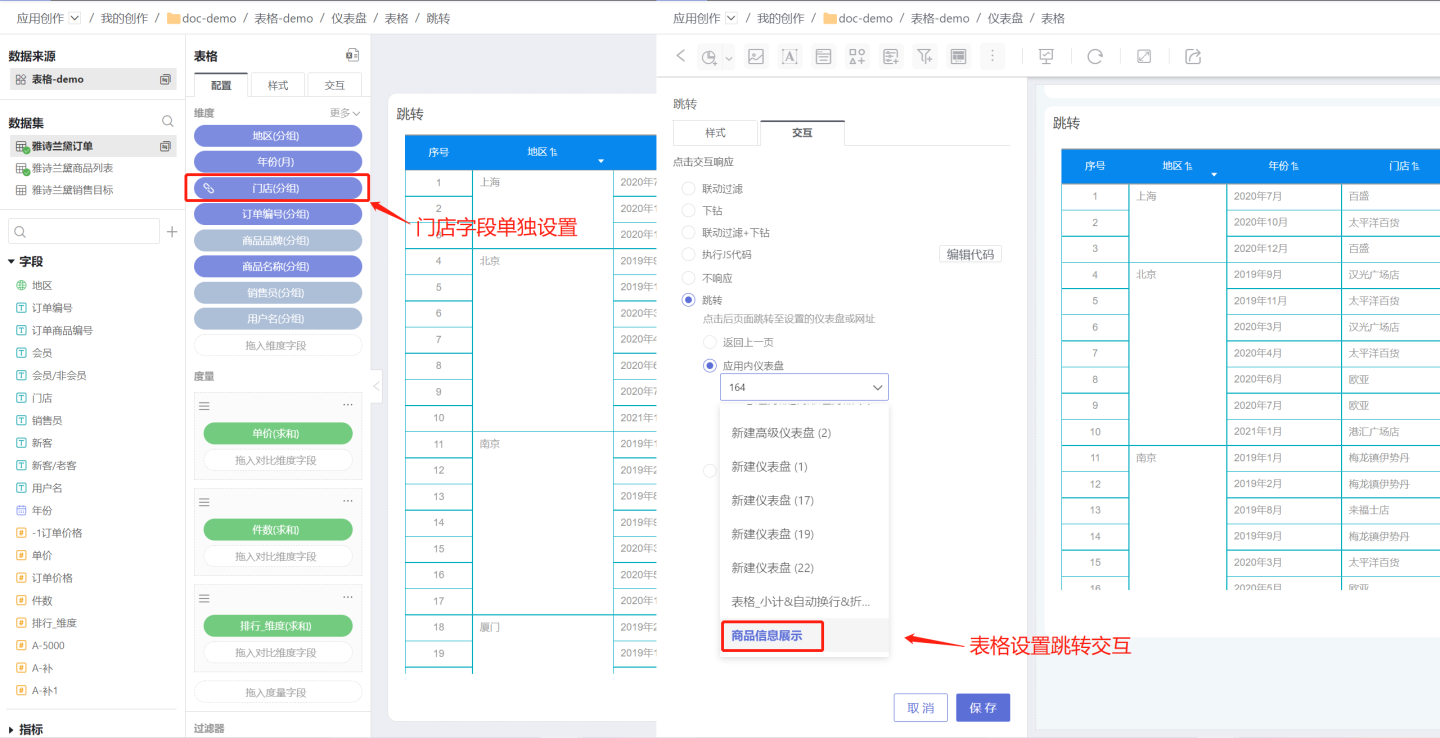
Tip
- The navigation content settings for field navigation and table control navigation are the same. For detailed settings, please refer to the Control Settings -> Navigation section.
- Navigation settings only take effect on cells. Clicking on a cell executes the navigation operation, while clicking on the header does not trigger the navigation operation.
- Table control navigation applies to all fields in the table. When a field has navigation set, it is no longer affected by the table control navigation.
- Comparison dimensions in measures do not support setting field navigation.
Information Desensitization
Tables often contain sensitive information such as card numbers, phone numbers, and ID numbers, which need to be desensitized when displayed to protect user privacy. The system supports desensitization settings for table content, allowing users to set desensitized content as needed. It supports multiple desensitization content setting methods and custom desensitization content.
Below is how to set up information desensitization.
Select the field that requires information desensitization, click the dropdown menu on the right to enter the information desensitization setting interface.
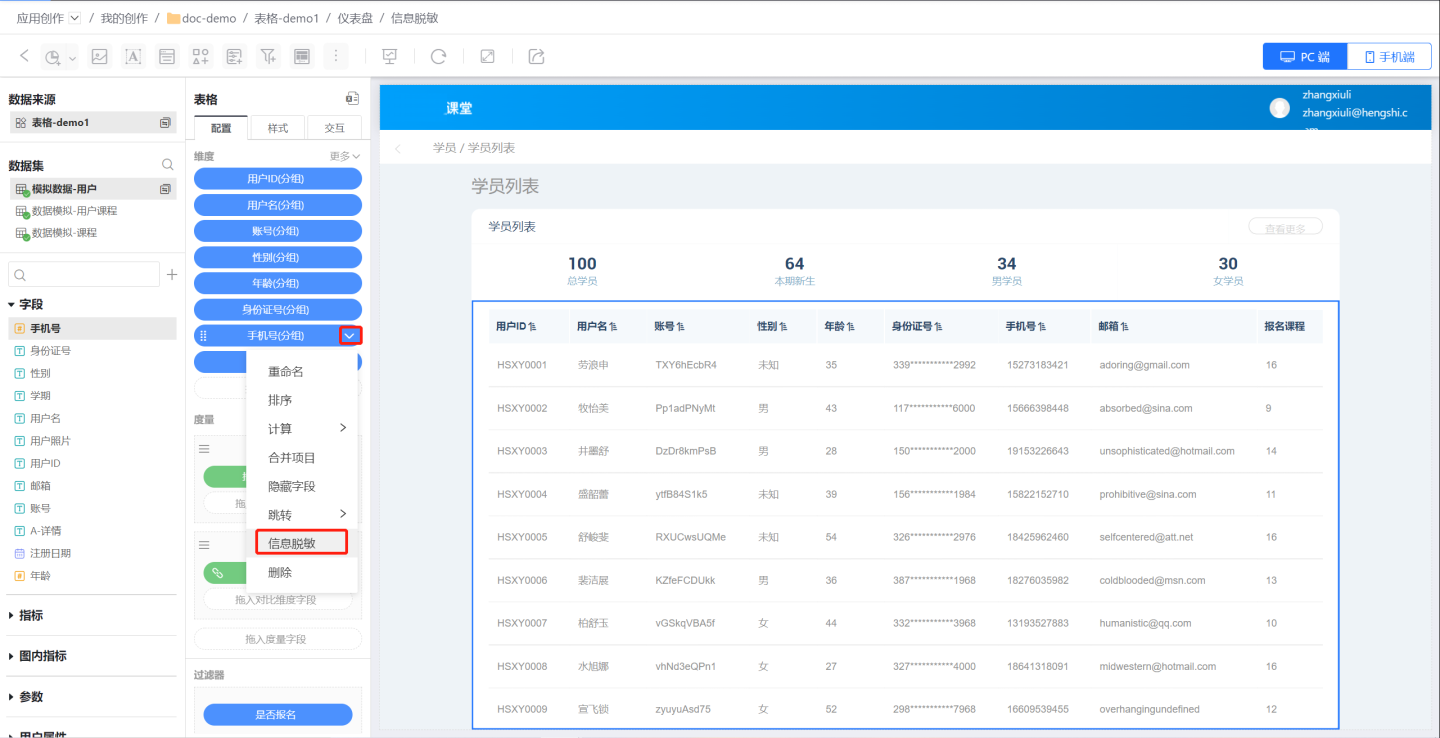
Set up information desensitization.
First, set the desensitization content. The retention setting refers to the content in the field that is not desensitized, while other content is desensitized. In the example, the first 3 and last 4 digits are retained, and the content in between is desensitized.
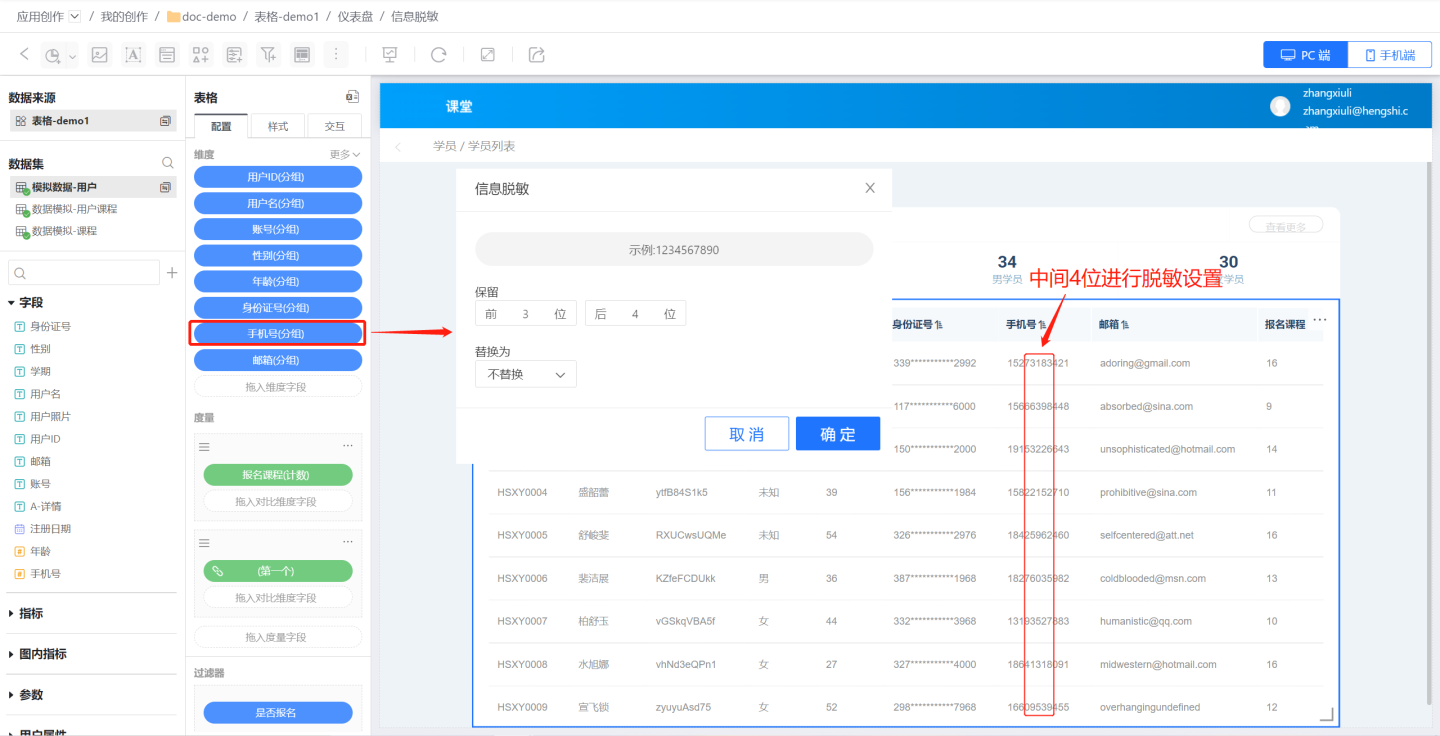
Replace sensitive information. Replace the desensitized content, supporting single replacement, overall replacement, and no replacement.
- Overall replacement: Refers to replacing the desensitized information as a whole. For example, using
***to replace the desensitized information as a whole, the 4 desensitized characters in the phone number will be replaced by***, and the 11 desensitized characters in the ID number will be replaced by***.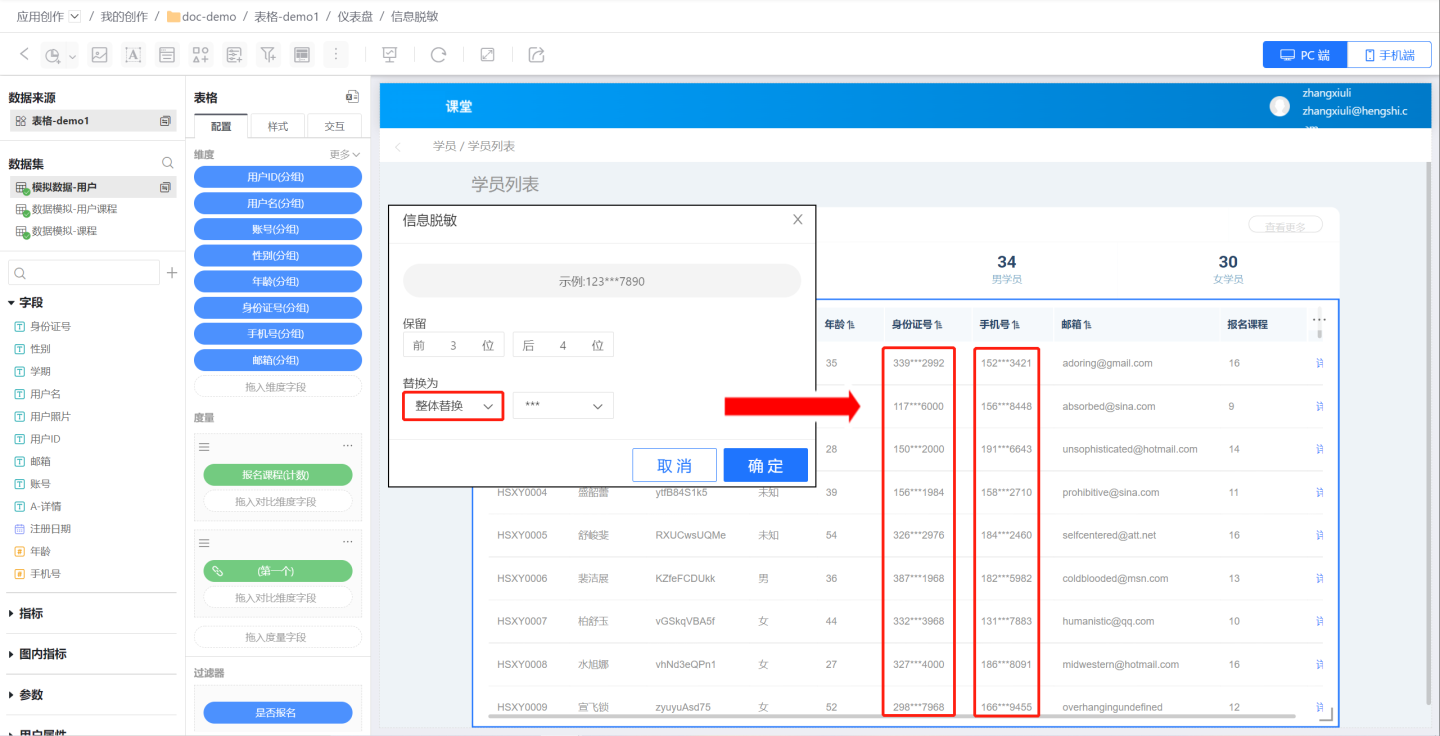 - Single replacement: Refers to using replacement characters to replace the desensitized information one by one. For example, using
- Single replacement: Refers to using replacement characters to replace the desensitized information one by one. For example, using *to replace the desensitized information, the 4 desensitized characters in the phone number will be replaced by 4*characters, and the 11 desensitized characters in the ID number will be replaced by 11*characters.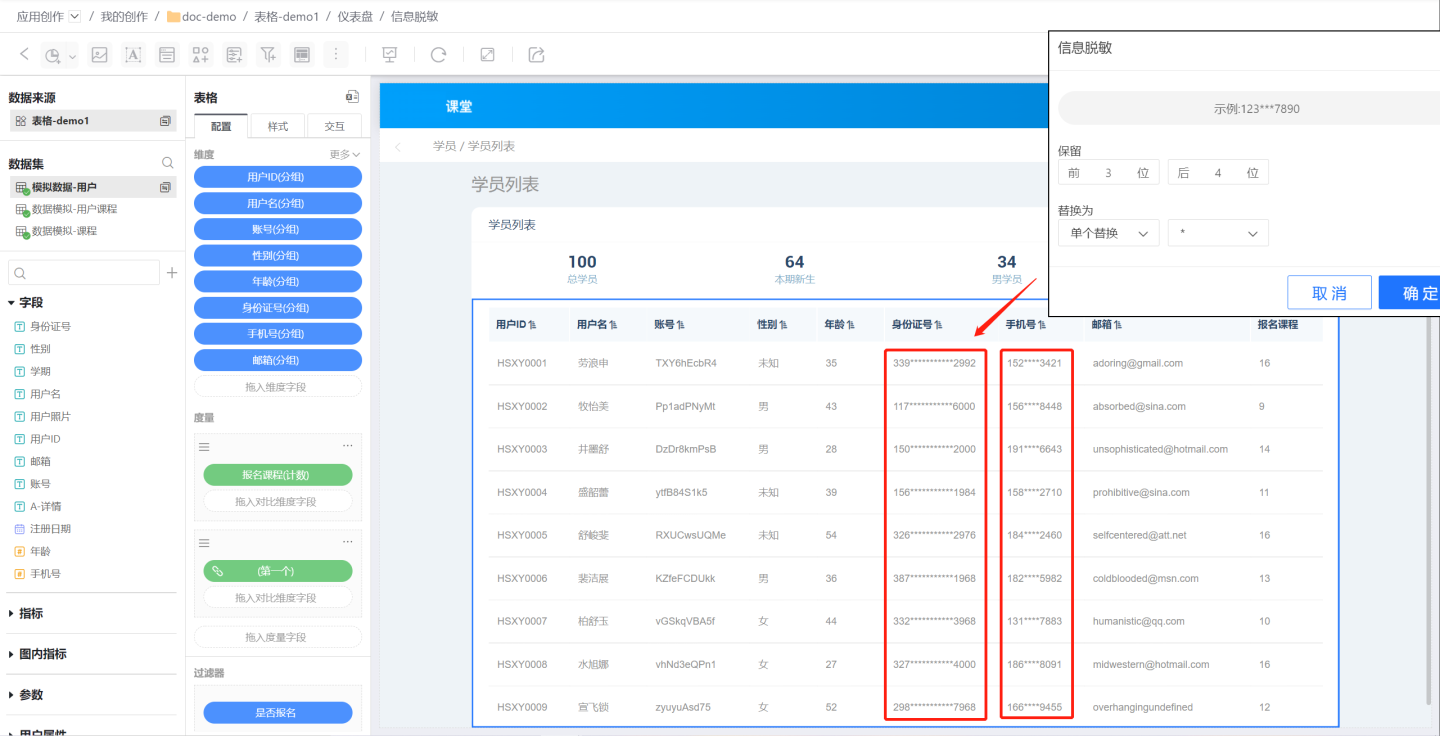 - No replacement: Refers to the desensitized information not being replaced, commonly used in scenarios where desensitization settings are canceled.
- No replacement: Refers to the desensitized information not being replaced, commonly used in scenarios where desensitization settings are canceled.
- Overall replacement: Refers to replacing the desensitized information as a whole. For example, using
Replacement content: Supports using
*,Xcharacters for desensitized information replacement, and also supports custom replacement content.
- Other scenario descriptions. When the field content length varies, it may happen that a cell's content does not meet the retention condition, such as retaining the first 4 characters, but the cell only has 1 character, which is less than the retention requirement. In this case, all characters will be retained, and a desensitization replacement character will be added to indicate that the cell has been desensitized. The example shows the information replacement situation when the cell length does not meet the retention condition under two scenarios: retaining the first 4 digits and retaining the last 4 digits.

Row and Column Transposition
The table supports the row and column transposition function. Click the "+" on the right side of the dimension to select row and column transposition. After transposition, except for the folded dimensions, other styles and dynamic effects remain basically unchanged. 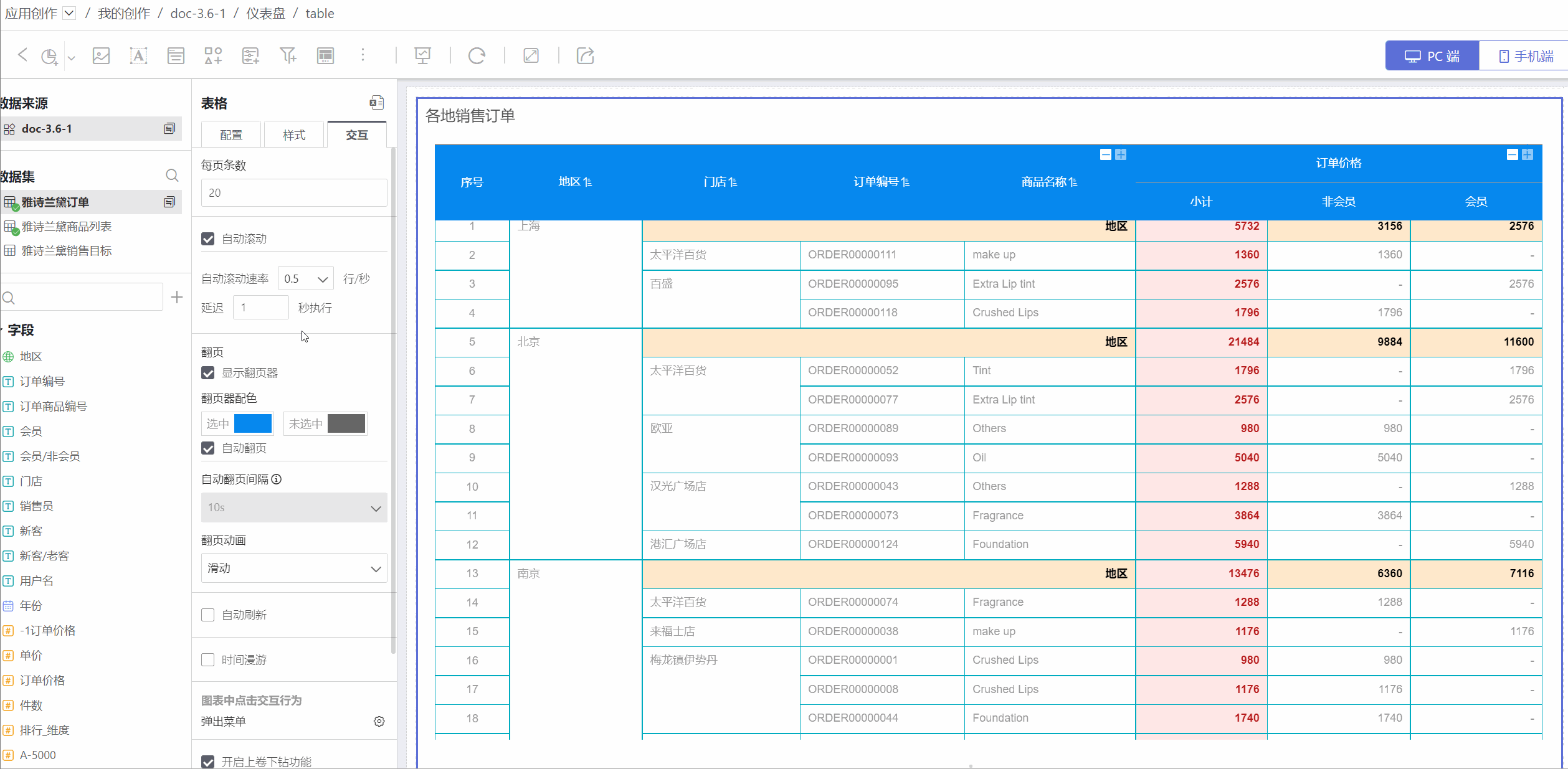
Dimension Subtotal
The table supports the dimension subtotal function. Click the "+" on the right side of the dimension to add a subtotal.
You can select a dimension field to add a subtotal, which calculates the subtotal for the current dimension group. The subtotal of the main dimension is displayed at the bottom of the dimension values in the table, and the subtotal of the secondary dimension is calculated based on the cells of its upper-level dimension group.
Supports selecting multiple dimension fields to add a combined subtotal.

Choose the calculation method for the subtotal. The calculation method for the subtotal can be independent of the calculation method of the measure. In the example, the subtotal of the order price is selected as the maximum value, and the quantity is selected as the sum. The default calculation method for the subtotal is automatic, meaning it follows the calculation method of its measure. If a measure does not need to display a subtotal, simply uncheck it.
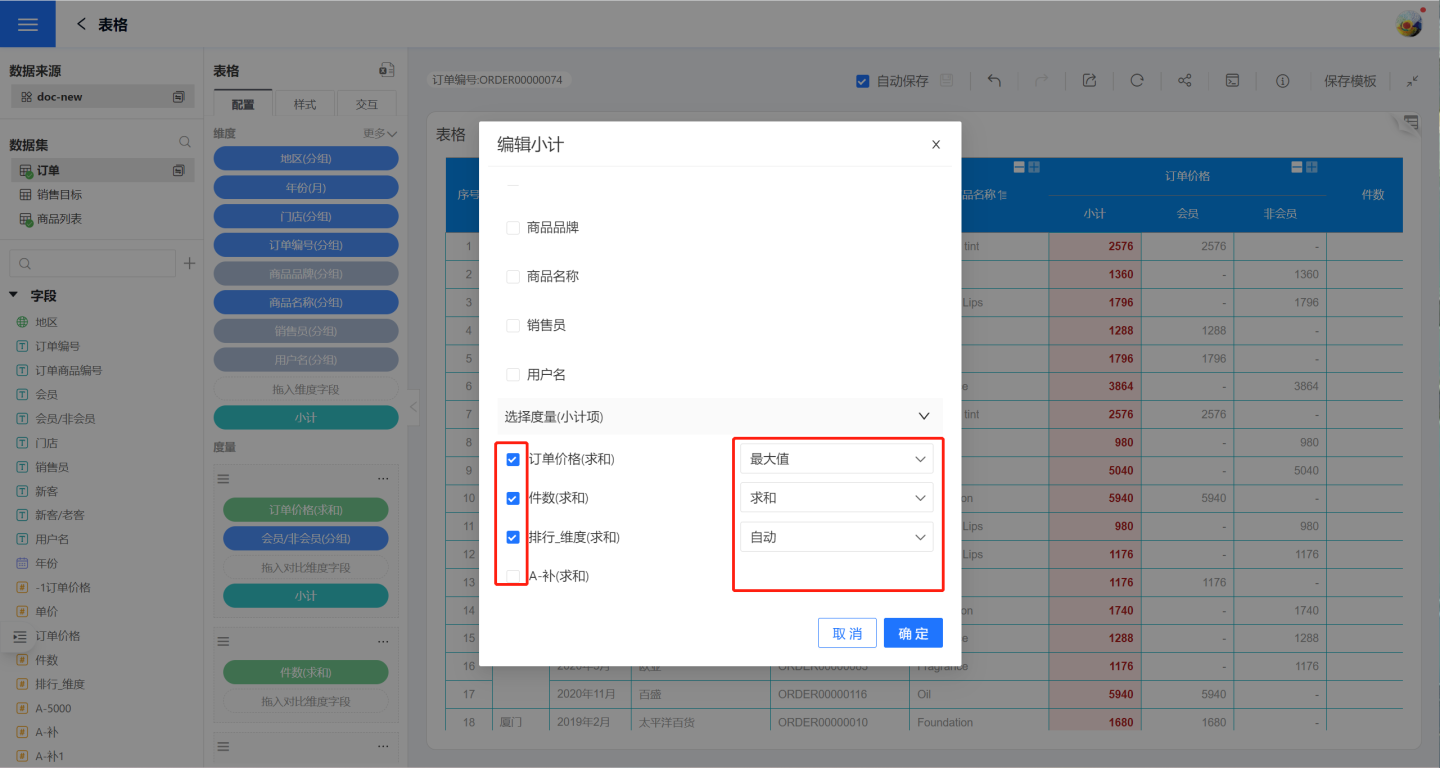
Tip
Dimension subtotal supports style settings, allowing you to adjust the position, color, background, etc. of the subtotal. For detailed operations, please refer to Subtotal Style Adjustment.
Sorting Levels
When sorting a table, the primary dimension is sorted first, and the secondary dimension is sorted based on the primary dimension. Therefore, table sorting is related to the order of dimensions. When users want to change the table sorting without altering the dimension order, they can achieve this by enabling custom sorting levels. Custom sorting levels sort the table according to the custom dimension order without affecting the original dimension display of the table.
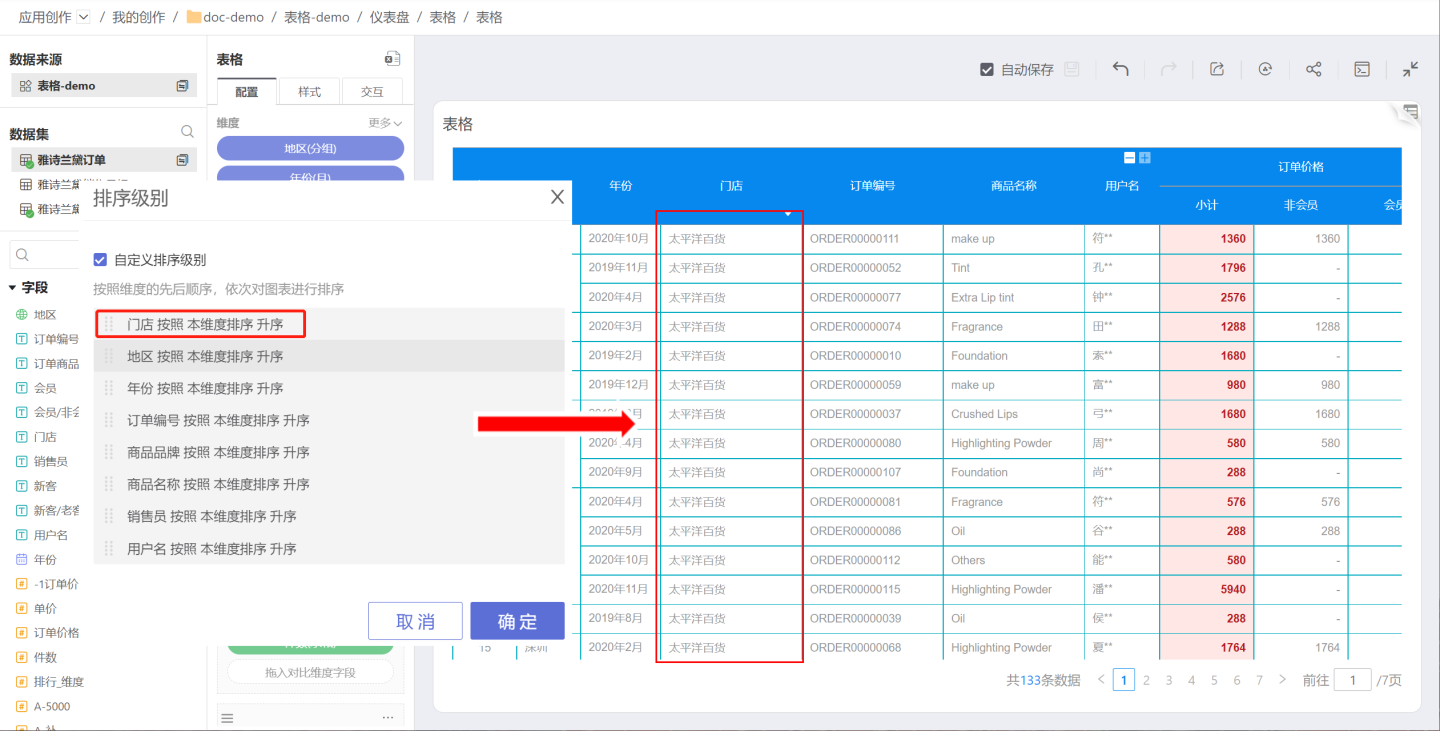
Measures
- Multiple measures can be added to the measure area.
- Measures added to the table are arranged sequentially after the dimensions, following the principle of dimensions first and measures last.
- Users can customize and modify the names of measures.
Comparison Dimension Fields
Each measure supports adding one or more comparison dimensions to display data, such as showing order prices based on the comparison dimensions of members and non-members. 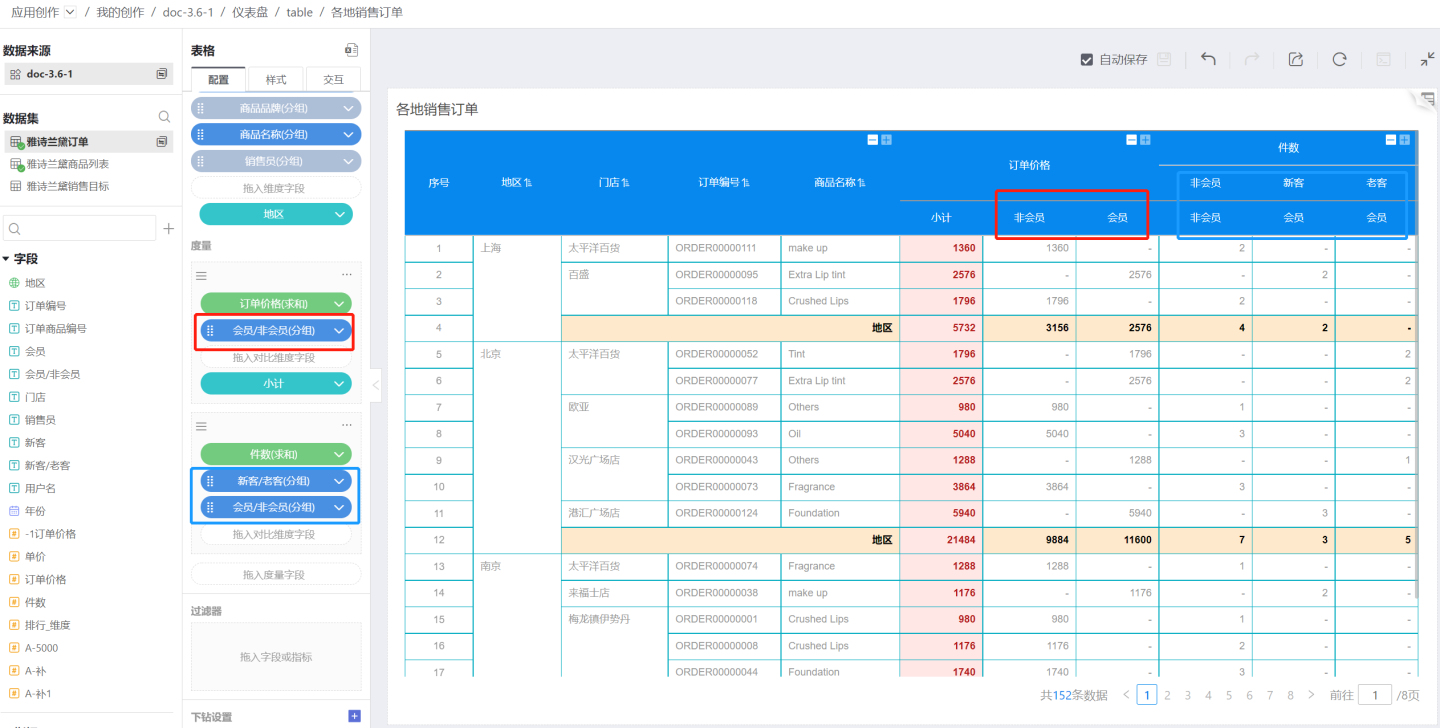
The number of columns displayed in the measure depends on how many groups exist in the comparison dimension. For example, the comparison dimension of order prices is only divided into two groups: members and non-members. The number of columns in the comparison dimension cannot exceed 512.
Comparison dimensions support sorting. Click the downward triangle on the right side of the comparison dimension to pop up the menu, and then click sort. The sorting method is the same as the dimension sorting method, and you can refer to the dimension sorting for settings.
Create a Copy
Creating a copy is the process of creating another measure with the same content as this one. It allows for quickly creating a new measure by replacing the measure or contrasting dimensions. As shown in the figure, the ranking is created by making a copy, only replacing the measure field. 
Measure Subtotal
Click the "+" on the right side of each measure to add a subtotal. Multiple options are supported for subtotals.
Select only the comparison dimension field to add a subtotal, which calculates the subtotal for the current row, as shown in the figure.
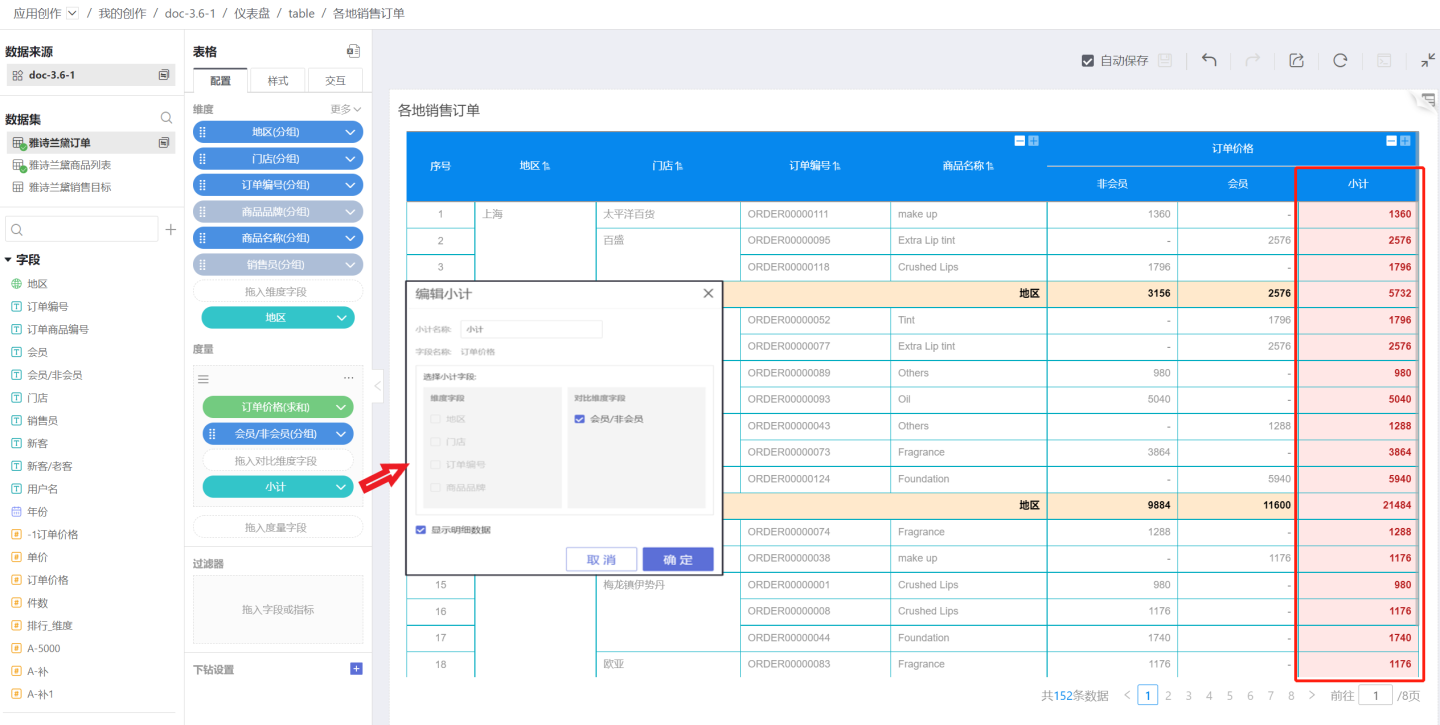
Select only the dimension field to add a subtotal, which calculates the subtotal for the current comparison dimension group column, and the header is named after the comparison dimension.
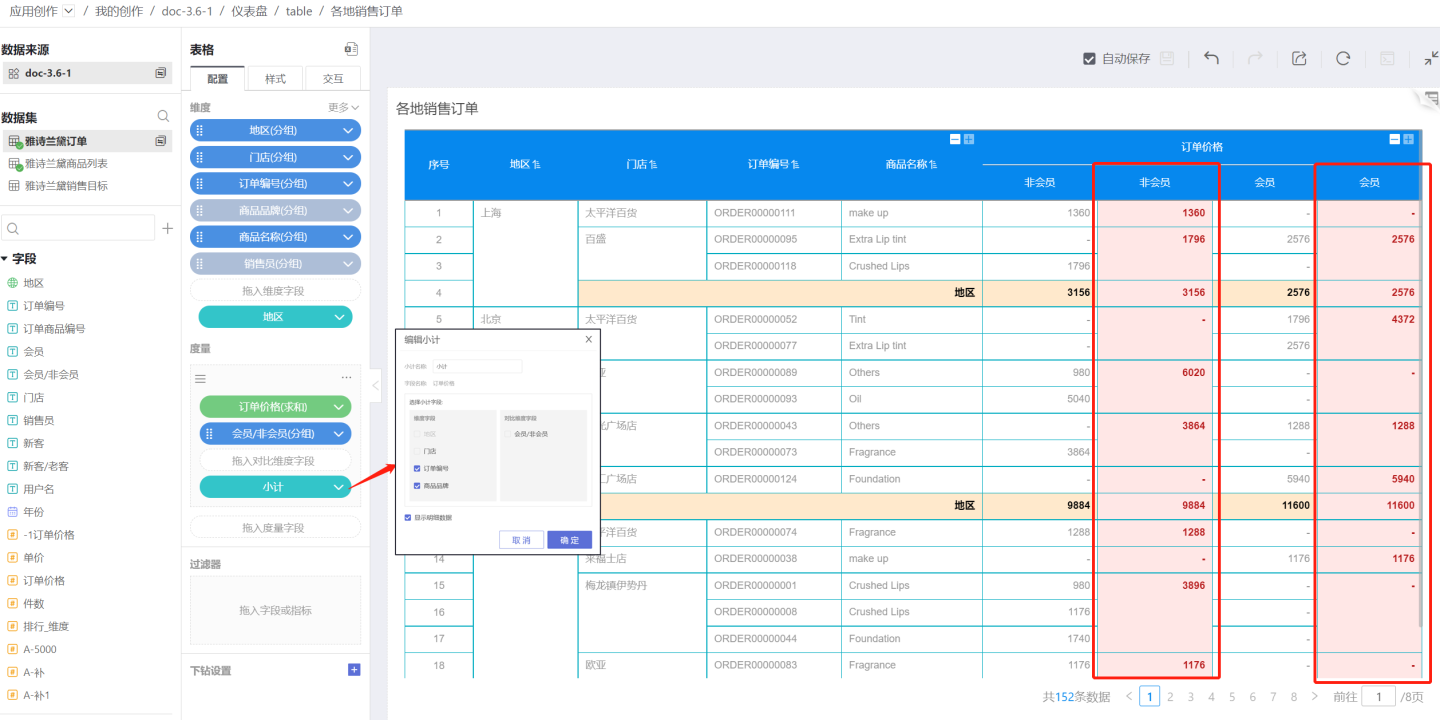
Select both the dimension field and the comparison dimension field to add a combined subtotal, which calculates the total for all current rows. The added combined subtotal is displayed on the far right of the table.
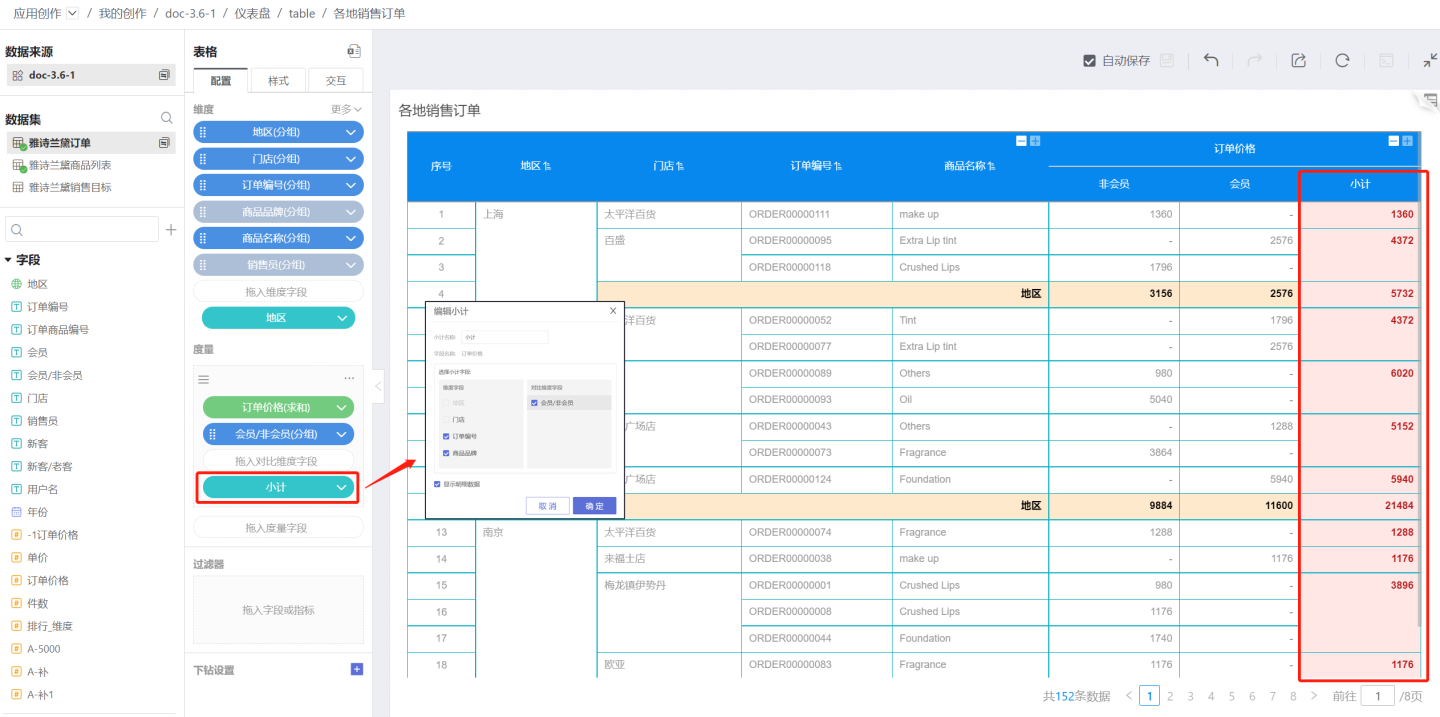
When "Show detailed data" is checked, detailed data is displayed in the table. When unchecked, detailed data is not shown in the table. The example shows the table when "Show detailed data" is unchecked.
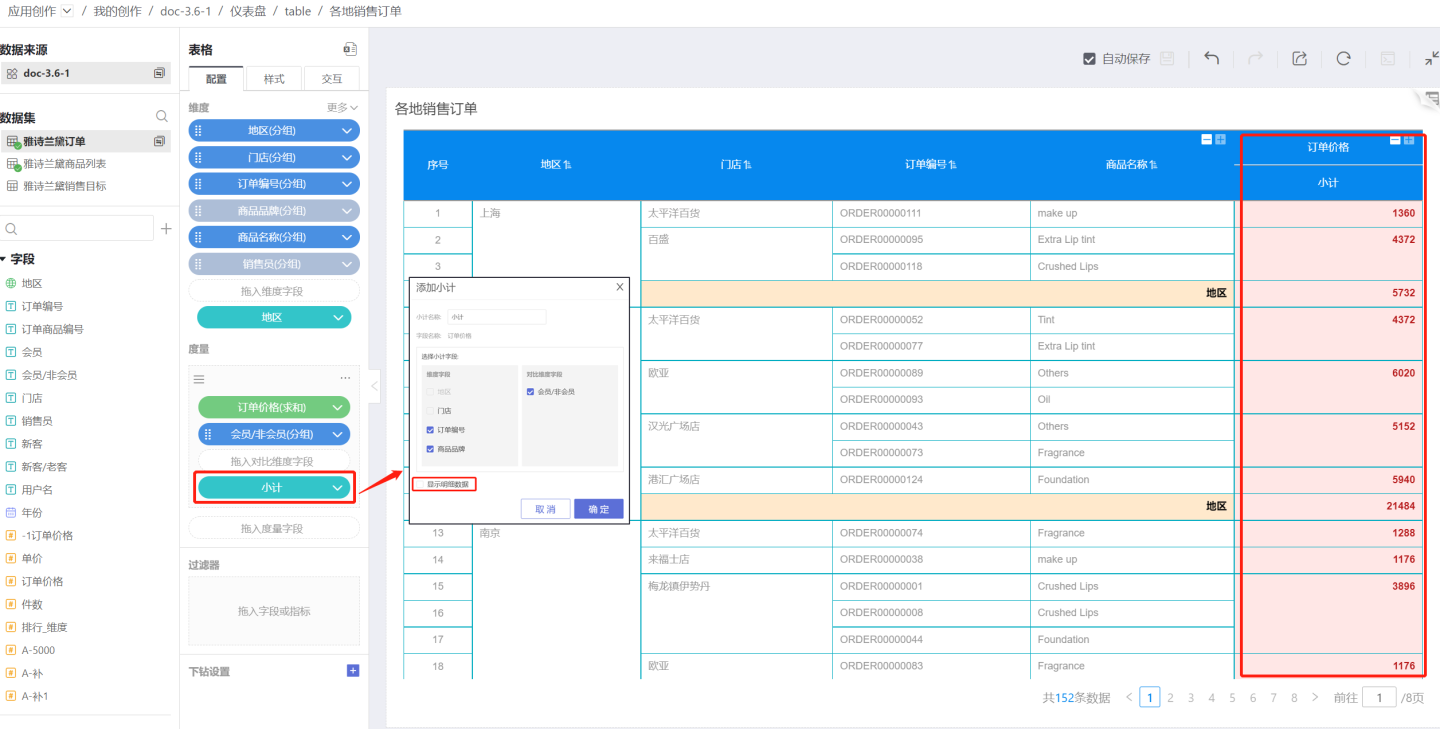
Note
When adding a measure subtotal, if selecting a dimension field, it must be chosen from the bottom dimension, i.e., starting from the last sub-dimension and moving up one level.
Convert to Group
Convert this measure into a measure group. The header of the measure group is displayed above the current measure, and users can customize the name of the measure group.
A measure group can use the same measure with different filter conditions, primarily used to display comparisons of the same set of calculation indicators under different environments (filter conditions).
Multiple groups can be merged for display, as shown in the figure. 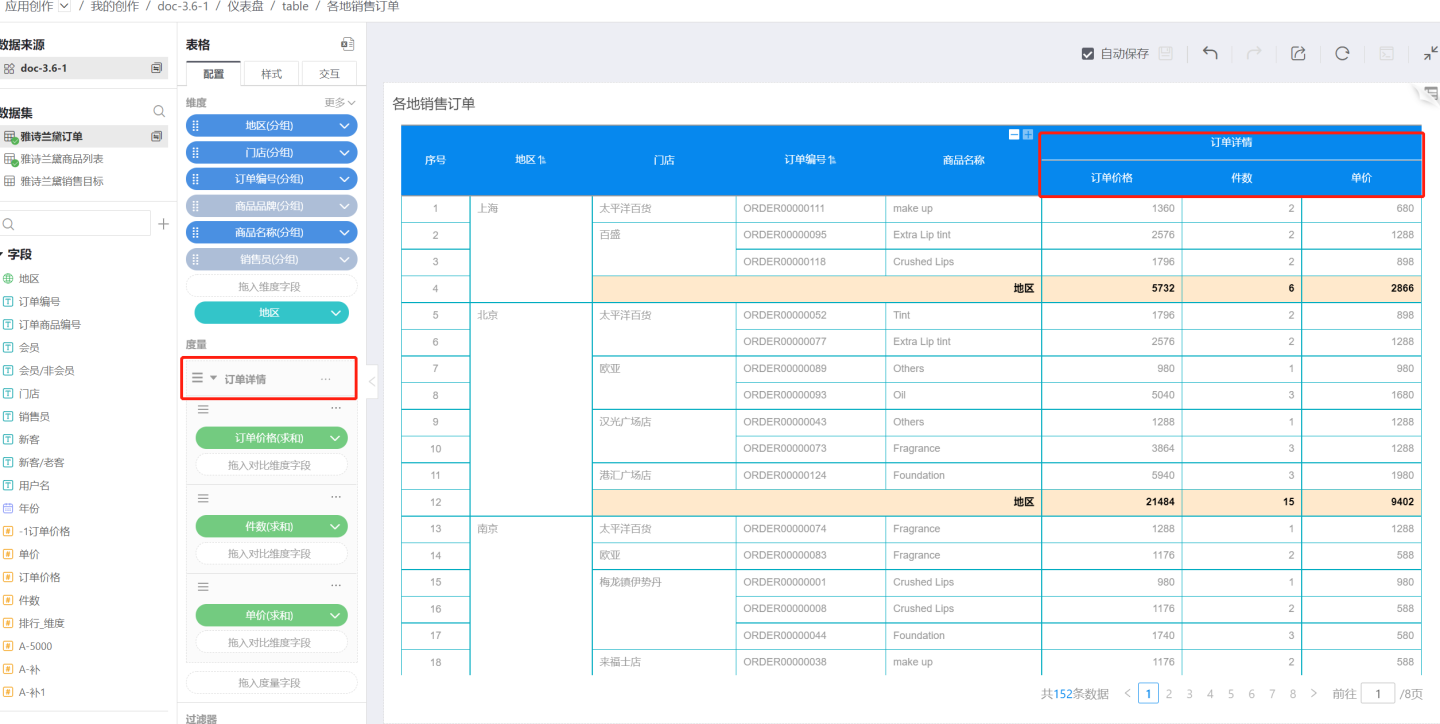
Add Filter
Add filter conditions to this measure to determine which data should be displayed in the details based on the filter conditions.
Table Related Settings
Filters
Please refer to the Filters section in the chart documentation.
Tip
Currently, filtering on raw fields affects subtotals, while filtering on calculated metrics and in-chart metrics does not affect subtotals.
Drill-down Settings
Tables support setting drill-down layers. Please refer to the Chart Drill-down instructions for setup.
Table Styles
Tables support a variety of style settings. Please refer to Table Styles for configuration.
Table Interaction Operations
Tables can be configured with various interaction operations such as scrolling, pagination, click pop-ups, etc. They also support interactions with other charts in the dashboard, such as linking to other charts, jumping, etc. Please refer to the corresponding sections for setup.
Table Operations
Table Data Export
When exporting table data, the data types are preserved, facilitating secondary calculations on the exported data. Date type data supports processing with date functions, and the prefixes or suffixes of numeric type data do not affect the calculation results.
The following settings are supported during data export:
- Export cell styles to ensure the exported data matches the displayed table.
- Export desensitized data in plain text, allowing individuals with data permissions to view the complete desensitized data.
- Export data filter conditions, providing viewers with a clearer understanding of the data context.
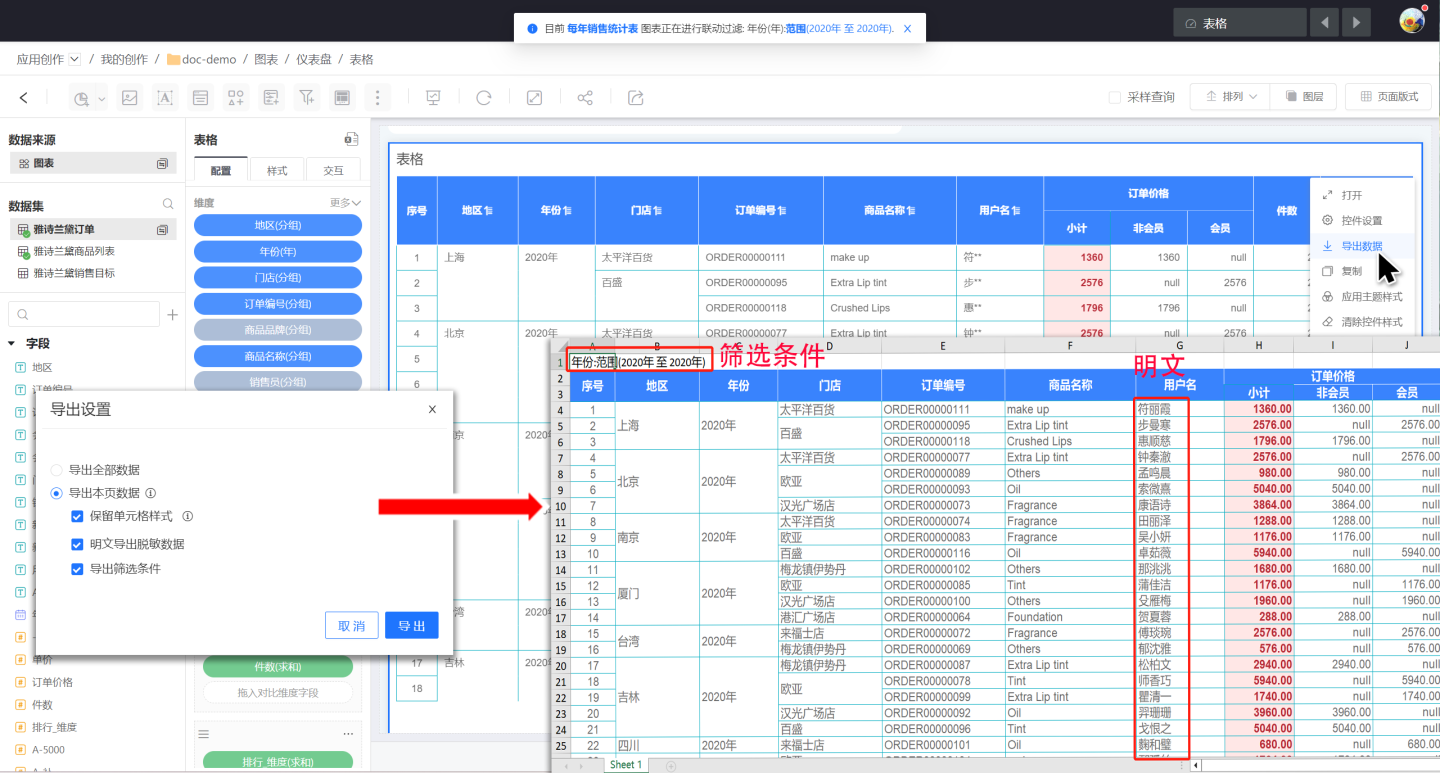
Note
Table cell styles, plain text, and filter conditions can only be exported when exporting the current page. These features are not supported when exporting all data.